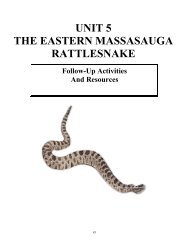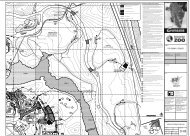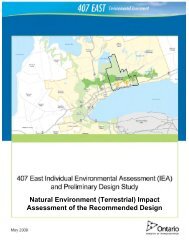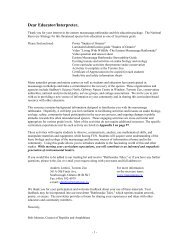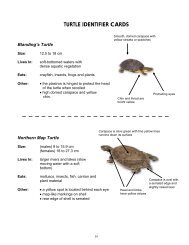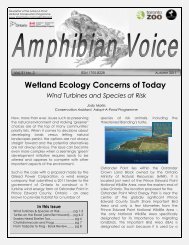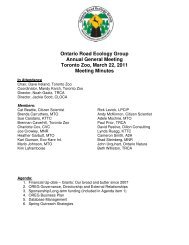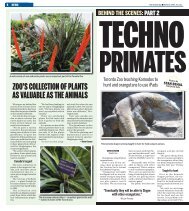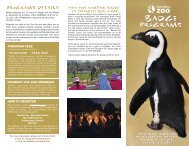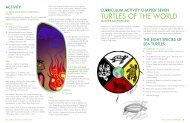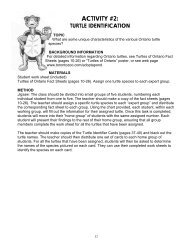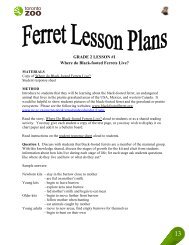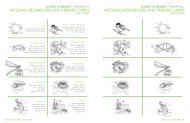A Guide to Road Ecology in Ontario (pdf) - Toronto Zoo
A Guide to Road Ecology in Ontario (pdf) - Toronto Zoo
A Guide to Road Ecology in Ontario (pdf) - Toronto Zoo
Create successful ePaper yourself
Turn your PDF publications into a flip-book with our unique Google optimized e-Paper software.
A <strong>Guide</strong> <strong>to</strong> <strong>Road</strong> <strong>Ecology</strong> <strong>in</strong> <strong>Ontario</strong>
<strong>Ontario</strong> <strong>Road</strong> <strong>Ecology</strong> Group, Toron<strong>to</strong> <strong>Zoo</strong>. 2010.<br />
A <strong>Guide</strong> <strong>to</strong> <strong>Road</strong> <strong>Ecology</strong> <strong>in</strong> <strong>Ontario</strong>, prepared for the<br />
Environment Canada Habitat Stewardship Program for Species at Risk.<br />
ISBN: 978-1-89541-50-6<br />
Published by:<br />
<strong>Ontario</strong> <strong>Road</strong> <strong>Ecology</strong> Group<br />
Toron<strong>to</strong> <strong>Zoo</strong><br />
361A Old F<strong>in</strong>ch Avenue<br />
Scarborough, <strong>Ontario</strong><br />
M1B 5K7<br />
www.wildlifeonroads.org<br />
Pr<strong>in</strong>ted <strong>in</strong> Canada<br />
Art Direction and Design by NEO Communications
PREFACE<br />
<strong>Road</strong> <strong>Ecology</strong> is the study of the <strong>in</strong>teraction between road networks and the natural environment. The<br />
field exam<strong>in</strong>es and addresses the effects of roads on wildlife populations and <strong>in</strong>vestigates how roads<br />
<strong>in</strong>fluence ecological processes. <strong>Road</strong> ecology is an emerg<strong>in</strong>g science that is ga<strong>in</strong><strong>in</strong>g momentum as<br />
citizens and transportation planners strive <strong>to</strong> achieve efficient road networks that work <strong>in</strong> harmony<br />
with and conserve the natural environment.<br />
This guide is a resource for students, citizens, government and non-government agencies. It is a <strong>to</strong>ol<br />
that 1) raises awareness about the threats of roads <strong>to</strong> biodiversity <strong>in</strong> <strong>Ontario</strong> and 2) provides solutions<br />
for mitigat<strong>in</strong>g these threats. The focus is on wildlife/road <strong>in</strong>teractions and local road ecology projects<br />
are provided as examples. This dynamic document is <strong>in</strong>tended <strong>to</strong> present the latest <strong>in</strong> road ecology<br />
<strong>in</strong>itiatives and <strong>in</strong>spire susta<strong>in</strong>able road practices.<br />
2<br />
Front Cover © Bob Bowles<br />
Opposite © Mandy Karch.
TABLE OF CONTENTS<br />
Preface 2<br />
Introduction : <strong>Road</strong>s <strong>in</strong> Southern <strong>Ontario</strong> 6<br />
Threats of <strong>Road</strong>s <strong>to</strong> Wildlife and the Environment<br />
Direct Mortality: Wildlife/Vehicle Collisions 10<br />
Habitat Loss 13<br />
Habitat Fragmentation/Connectivity 15<br />
Habitat Degradation 17<br />
<strong>Road</strong> <strong>Ecology</strong> : A Citizen’s <strong>Guide</strong><br />
How <strong>to</strong> Conserve the Environment and Avoid a Wildlife/Vehicle Collision 20<br />
How <strong>to</strong> Safely Move Wildlife Off the <strong>Road</strong> 27<br />
Applied <strong>Road</strong> <strong>Ecology</strong> Solutions<br />
M<strong>in</strong>imiz<strong>in</strong>g the Effects of <strong>Road</strong>s on the Environment and Biodiversity 30<br />
Exclusion Fenc<strong>in</strong>g 35<br />
Ecopassages 38<br />
Wildlife Cross<strong>in</strong>g Signs 45<br />
<strong>Road</strong> <strong>Ecology</strong> Research<br />
Wildlife Population <strong>Road</strong> Mortality Thresholds 48<br />
Prioritiz<strong>in</strong>g <strong>Road</strong> Mitigation <strong>in</strong> <strong>Ontario</strong> with Connectivity Model<strong>in</strong>g 48<br />
The <strong>Ontario</strong> <strong>Road</strong> <strong>Ecology</strong> Group 54<br />
References 58<br />
Additional <strong>Road</strong> <strong>Ecology</strong> Resources 61<br />
Appendix : <strong>Ontario</strong> Species At Risk Threatened by <strong>Road</strong>s 63<br />
4<br />
Opposite © Jan<strong>in</strong>e Holman.
INTRODUCTION<br />
INTRODUCTION : ROADS IN SOUTHERN ONTARIO<br />
<strong>Road</strong>s are gateways <strong>to</strong> development and when a road is built, hous<strong>in</strong>g and <strong>in</strong>dustrialization soon<br />
follow. The pressure of urban encroachment on wildlife populations is becom<strong>in</strong>g more <strong>in</strong>tense. In<br />
only 60 years the major roads of southern <strong>Ontario</strong> have <strong>in</strong>creased from 7,133 km <strong>to</strong> 35,637 km<br />
(Fenech et al. 2000; Figure 1). Today, no po<strong>in</strong>t <strong>in</strong> the region is more than 1.5 km from a road<br />
(Gunson 2010).<br />
In addition <strong>to</strong> hav<strong>in</strong>g the greatest density of people and roads, southern <strong>Ontario</strong> also has the greatest<br />
biodiversity <strong>in</strong> the prov<strong>in</strong>ce (Figure 2). There are 203 *Species at Risk (SAR) found <strong>in</strong> <strong>Ontario</strong> and<br />
many of these are negatively affected by roads (see Appendix).<br />
Natural cover and habitat are shr<strong>in</strong>k<strong>in</strong>g <strong>in</strong> southern <strong>Ontario</strong>. The trend will cont<strong>in</strong>ue as it is<br />
estimated that the population of the Greater Golden Horseshoe area alone will <strong>in</strong>crease by over 3<br />
million residents over the next 20 years (Growth Plan for the Greater Golden Horseshoe 2006). To<br />
accommodate this growth and address exist<strong>in</strong>g highway congestion, the M<strong>in</strong>istry of Transportation<br />
of <strong>Ontario</strong> (MTO) has proposed road expansion projects and ma<strong>in</strong>tenance work that will enhance<br />
mo<strong>to</strong>rist safety and efficiency on prov<strong>in</strong>cial highways (Southern Highways Program 2008 <strong>to</strong> 2012;<br />
Figure 3). A portion of these projects may take place <strong>in</strong> identified greenspaces such as the Oak<br />
Ridges Mora<strong>in</strong>e, Greenbelt and Niagara Escarpment.<br />
Quick Fact :<br />
*Species at Risk (SAR) are<br />
any naturally-occurr<strong>in</strong>g plant or<br />
animal <strong>in</strong> danger of ext<strong>in</strong>ction<br />
or of disappear<strong>in</strong>g from the<br />
prov<strong>in</strong>ce. Once classified<br />
as “at risk”, they are added<br />
<strong>to</strong> the Species at Risk <strong>in</strong><br />
<strong>Ontario</strong> (SARO) List (<strong>Ontario</strong><br />
M<strong>in</strong>istry of Natural Resources<br />
2009). Milksnake (Below),<br />
Lampropeltis triangulum,<br />
(OMNR Status: Special<br />
Concern).<br />
© Mandy Karch.<br />
Conservation of resources <strong>in</strong>clud<strong>in</strong>g the land, the environment and biodiversity is essential for<br />
communities <strong>to</strong> prosper and endure. We are enter<strong>in</strong>g a new era of technology, understand<strong>in</strong>g<br />
and imag<strong>in</strong>ation. As a society, we must acknowledge the consequences of development<br />
and resource consumption and proceed responsibly. Only by protect<strong>in</strong>g our water sources,<br />
wetlands, woodlots, biodiversity and agricultural land will we thrive socially and economically.<br />
Opposite © Mandy Karch.
Figure 1 : <strong>Road</strong> density (red l<strong>in</strong>es) <strong>in</strong> southern <strong>Ontario</strong> (source: Eco-Kare International).<br />
Figure 2 : Species at Risk (SAR) richness <strong>in</strong> <strong>Ontario</strong> (source: Project WILDSPACE TM ).
Figure 3 : Prov<strong>in</strong>cial Highways Construction Program - Plann<strong>in</strong>g for the Future<br />
(source: Southern Highways Program 2008-2012).<br />
INTRODUCTION<br />
Quick Fact :<br />
<strong>Road</strong>s are a major threat<br />
<strong>to</strong> the persistence of the<br />
loggerhead shrike, Lanius<br />
ludovicianus, (OMNR<br />
Status: Endangered).<br />
Habitat loss and<br />
fragmentation and road kill<br />
are some of the hazards<br />
that threaten this species.<br />
Habitat degradation is<br />
another as roads facilitate<br />
the spread of <strong>in</strong>vasive<br />
plant species that displace<br />
optimal shrike habitat.<br />
<strong>Road</strong> salt, noise and light<br />
pollution also degrade<br />
habitat and negatively affect<br />
this endangered species.<br />
© Ken Ardill.
THREATS<br />
THREATS OF ROADS TO WILDLIFE AND THE ENVIRONMENT<br />
Direct Mortality : Wildlife/Vehicle Collisions (WVC’s)<br />
<strong>Road</strong>s pose risks <strong>to</strong> wildlife that <strong>in</strong>clude<br />
direct mortality, habitat loss, habitat<br />
fragmentation and habitat degradation.<br />
Probably the most important impact of roads on wildlife populations is the direct mortality<br />
of animals as they are hit and killed by vehicles on roads <strong>in</strong> wildlife/vehicle collisions<br />
(WVC’s). Mortality directly reduces wildlife population sizes. S<strong>in</strong>ce small populations are more<br />
vulnerable <strong>to</strong> ext<strong>in</strong>ction than are large populations, population reduction from road mortality causes<br />
an <strong>in</strong>crease <strong>in</strong> the chance of population ext<strong>in</strong>ction. Many of the Species at Risk whose populations<br />
are affected by roads (see Appendix) are slow-mov<strong>in</strong>g animals, such as reptiles and amphibians that<br />
do not readily avoid roads or vehicles (Fahrig and Rytw<strong>in</strong>ski 2009). These species can experience<br />
extremely high mortality rates due <strong>to</strong> roads. Large preda<strong>to</strong>r species, which are wide-rang<strong>in</strong>g<br />
and have low natural densities, are also highly susceptible <strong>to</strong> the effects of road mortality on their<br />
populations; even a small number of WVC’s can endanger populations of such species (Table 1).<br />
Transportation agencies tend <strong>to</strong> th<strong>in</strong>k of WVC’s as those <strong>in</strong>volv<strong>in</strong>g large animals such as deer,<br />
because these are the WVC’s that are reported <strong>to</strong> the police. However, these represent only a t<strong>in</strong>y<br />
fraction of all WVC’s. For example, <strong>in</strong> <strong>Ontario</strong>, there are between 14,000 and 15,000 reported<br />
WVC’s each year, almost all of which <strong>in</strong>volve collisions with large herbivores – deer and moose. In<br />
contrast, there were over 24,000 vertebrate collisions <strong>in</strong>clud<strong>in</strong>g reptiles and amphibians on a 31 km<br />
stretch of road on the Thousand Islands Parkway <strong>in</strong> only a 5 month study period (Eberhardt 2008).<br />
WVC’s <strong>in</strong>volv<strong>in</strong>g deer and moose jeopardize mo<strong>to</strong>rist safety, and millions of dollars are spent on<br />
these collisions every year <strong>in</strong> medical costs, vehicular repairs, <strong>in</strong>surance, road clean-up, road repair,<br />
time spent off work and extra time spent <strong>in</strong> transportation on routes closed or slowed down due <strong>to</strong><br />
the accidents. As a result of the danger and cost, there is public support <strong>to</strong> mitigate these WVC’s.<br />
However, measures aimed specifically at keep<strong>in</strong>g deer and moose off roads may do little <strong>to</strong> mitigate<br />
the effects of roads on wildlife conservation, because these species’ populations are not the most<br />
affected by road mortality. In fact, populations of deer and moose appear <strong>to</strong> be quite resilient <strong>to</strong><br />
the effects of road mortality (Munro 2009). Fenc<strong>in</strong>g designed <strong>to</strong> keep deer and moose off roads is<br />
unlikely <strong>to</strong> prevent mortality of most species vulnerable <strong>to</strong> road mortality effects. Mitigation needs<br />
<strong>to</strong> be aimed at the species whose populations are most affected by road mortality, such as reptiles,<br />
amphibians, and mammalian carnivores. If roads occur or must be built through wildlife habitat, the<br />
first and most important objective for mitigat<strong>in</strong>g road effects and conserv<strong>in</strong>g wildlife should be <strong>to</strong> keep<br />
such animals off the roads.<br />
10<br />
Opposite © Josh See.
Table 1 : Characteristics that make a species susceptible <strong>to</strong> the threats of roads (from Forman et al. 2003).<br />
Effects of <strong>Road</strong>s<br />
Characteristics Mak<strong>in</strong>g a Species Vulnerable <strong>to</strong> <strong>Road</strong> Effects <strong>Road</strong> Mortality Habitat Loss Reduced Connectivity<br />
Attraction <strong>to</strong> <strong>Road</strong>side Habitat<br />
x<br />
Inability <strong>to</strong> Avoid Oncom<strong>in</strong>g Cars<br />
x<br />
High Intr<strong>in</strong>sic Mobility<br />
x<br />
Habitat Generalist<br />
x<br />
Multiple Resource Needs x x<br />
Large Area Requirements/Low Density x x x<br />
Low Reproductive Rate x x x<br />
Behavioural Avoidance of <strong>Road</strong>s<br />
x<br />
Quick Fact :<br />
The American badger, Taxidea taxus, is an endangered species<br />
(OMNR Status). The dense road network that runs through the heart<br />
of <strong>Ontario</strong>’s badger range and the propensity of this species <strong>to</strong> nest<br />
along roads <strong>in</strong>creases the risk of wildlife/vehicle collisions.<br />
© Phillipe Verkerk.
THREATS<br />
CASE STUDY<br />
Species at Risk <strong>Road</strong> Kill - MacTier area south of Parry Sound,<br />
<strong>Ontario</strong><br />
The tw<strong>in</strong>n<strong>in</strong>g of Highway 69 (Highway 400 north extension) south of Parry Sound bisected prime<br />
Massasauga rattlesnake and eastern hog-nosed snake terri<strong>to</strong>ry (both species are classified as<br />
threatened by the OMNR; Figure 4). Although mitigation<br />
measures were exercised dur<strong>in</strong>g construction and planned<br />
<strong>in</strong><strong>to</strong> the road design (e.g. exclusion fenc<strong>in</strong>g <strong>to</strong> keep snakes off<br />
the road), snake mortality has been an issue for this highway<br />
project.<br />
Figure 4a (Right) and 4b (Below) : Massasauga rattlesnake,<br />
Sistrurus catenatus; eastern hog-nosed snake, Heterodon<br />
platirh<strong>in</strong>os. © Mandy Karch.<br />
43
Habitat Loss<br />
<strong>Road</strong> construction consumes terrestrial and aquatic habitat result<strong>in</strong>g <strong>in</strong> :<br />
i. Reduced population sizes lead<strong>in</strong>g <strong>to</strong> <strong>in</strong>creased likelihood of population ext<strong>in</strong>ction (smaller<br />
populations are more likely <strong>to</strong> go ext<strong>in</strong>ct than larger populations)<br />
ii.<br />
iii.<br />
iv.<br />
Limited habitat availability <strong>to</strong> accommodate species range expansions <strong>in</strong> response <strong>to</strong> climate<br />
change<br />
Smaller <strong>in</strong>dividual home ranges caus<strong>in</strong>g chronic<br />
stress, reduced <strong>in</strong>dividual fitness and<br />
compromised population viability<br />
Environmental disturbances <strong>to</strong> *Natural Heritage<br />
Systems (NHS’s) (i.e. habitat loss with<strong>in</strong><br />
NHS’s disrupts wildlife populations, hydrological<br />
processes and ecological processes such as<br />
successional native plant growth)<br />
© Mandy Karch.
THREATS<br />
CASE STUDY<br />
Natural Heritage System – Bramp<strong>to</strong>n, <strong>Ontario</strong><br />
When a road is constructed, development often follows. <strong>Road</strong>s and development with<strong>in</strong> a NHS<br />
<strong>in</strong>terfere with ecological processes and threaten population persistence. For example, <strong>in</strong> 2001 the<br />
loss of the 8 hectare Mimico Marsh at Bramalea <strong>Road</strong> and Bovaird Drive <strong>in</strong> Bramp<strong>to</strong>n likely resulted<br />
<strong>in</strong> changes <strong>to</strong> surround<strong>in</strong>g water quality, flow and level as well as the loss of seven wetland dependent<br />
wildlife species <strong>in</strong> the watershed (Turn<strong>in</strong>g Over a New Leaf: The E<strong>to</strong>bicoke and Mimico Creeks<br />
Watersheds Report Card 2006).<br />
To improve the health of this NHS and <strong>to</strong> atta<strong>in</strong> natural cover targets set for the year 2025, the<br />
Toron<strong>to</strong> and Region Conservation Authority (TRCA) reported that over 1,500 hectares of natural cover<br />
(forest and wetland) had <strong>to</strong> be created <strong>in</strong> the E<strong>to</strong>bicoke and Mimico Creeks watersheds (TRCA 2007;<br />
Table 2).<br />
Table 2 : Natural cover targets of the E<strong>to</strong>bicoke and Mimico Creeks Watersheds (source: Turn<strong>in</strong>g Over<br />
a New Leaf: The E<strong>to</strong>bicoke and Mimico Creeks Watersheds Report Card 2006).<br />
Watershed<br />
2006 Natural<br />
Cover (Forest and<br />
Wetland)<br />
2025 Natural<br />
Cover Target<br />
Hectares of Created<br />
Habitat Required <strong>to</strong><br />
Meet 2025 Target<br />
E<strong>to</strong>bicoke Creek 5.47% 11% 1230<br />
Mimico Creek 2.36% 8% 443<br />
Quick Fact :<br />
A *Natural Heritage<br />
System (NHS) is a system<br />
made up of natural heritage<br />
features and areas, l<strong>in</strong>ked<br />
by natural corridors which<br />
are necessary <strong>to</strong> ma<strong>in</strong>ta<strong>in</strong><br />
biological and geological<br />
diversity, natural functions,<br />
viable populations of<br />
<strong>in</strong>digenous species, and<br />
ecosystems. These systems<br />
can <strong>in</strong>clude lands that have<br />
been res<strong>to</strong>red and areas<br />
with the potential <strong>to</strong> be<br />
res<strong>to</strong>red <strong>to</strong> a natural state<br />
(Section 6 of the Prov<strong>in</strong>cial<br />
Policy Statement 2005).<br />
14
Habitat Fragmentation/Connectivity<br />
Fragmentation is the degree <strong>to</strong> which natural habitat, once cont<strong>in</strong>uous, is divided <strong>in</strong><strong>to</strong> remnant<br />
isolated patches. Excessive fragmentation of the landscape by roads can alter wildlife movements<br />
and lead <strong>to</strong> <strong>in</strong>creased wildlife/vehicle collisions (WVC’s) as animals need <strong>to</strong> traverse more and more<br />
roads <strong>to</strong> access resources.<br />
Connectivity, from a wildlife perspective, is the ability for an <strong>in</strong>dividual <strong>to</strong> move through the landscape<br />
unimpeded by natural or human landscape features. <strong>Road</strong>s are one of the most prom<strong>in</strong>ent human<br />
features that create barriers <strong>to</strong> wildlife movement and thereby decrease connectivity.<br />
<strong>Road</strong>s that bisect and fragment habitat result <strong>in</strong> :<br />
i. Denied access <strong>to</strong> resources (e.g. habitat and mates)<br />
ii.<br />
Loss of genetic and species diversity<br />
a. Disrupted or reduced gene flow (i.e. reduced<br />
genetic variability, <strong>in</strong>breed<strong>in</strong>g)<br />
b. Wildlife/vehicle collisions (WVC’s)<br />
Each of these results may cause reduced populations which<br />
<strong>in</strong>creases the risk of ext<strong>in</strong>ction.<br />
© Mandy Karch.
THREATS<br />
CASE STUDY<br />
Snake Mortality Observation – Bruce Pen<strong>in</strong>sula, <strong>Ontario</strong><br />
Over a 3 month period between August and Oc<strong>to</strong>ber 2009, naturalists Glenn Reed and Theresa<br />
McKenzie counted 23 live and over 250 dead snakes on roads <strong>in</strong> the Northern Bruce Pen<strong>in</strong>sula<br />
Township. Mortality appeared consistent on road segments bisect<strong>in</strong>g suitable snake habitat. Among<br />
the dead were 6 Massasauga rattlesnakes (OMNR status: Threatened), 9 milk and 6 ribbon snakes<br />
(OMNR status: Special Concern). There were also garter, Dekay’s, r<strong>in</strong>g-necked, red-bellied, smooth<br />
green, northern water snakes and a female snake conta<strong>in</strong><strong>in</strong>g 30 fetal young among the road-killed<br />
specimens (Figure 5). The volume of mortality <strong>in</strong> this<br />
region and the loss of Species at Risk suggest that<br />
these snake populations would benefit from mitigation<br />
measures.<br />
Figure 5 : <strong>Road</strong> kill snakes from the Bruce Pen<strong>in</strong>sula,<br />
autumn 2009. © Glenn Reed.
Habitat Degradation<br />
<strong>Road</strong>s negatively affect land, water and air quality due <strong>to</strong> :<br />
i. Pollution<br />
a. Vehicle debris and particulate matter<br />
b. Combustion eng<strong>in</strong>e emissions<br />
c. De-ic<strong>in</strong>g agents (e.g. salt, w<strong>in</strong>d shield wiper fluids, etc.)<br />
d. Dust lead<strong>in</strong>g <strong>to</strong> siltation and sedimentation of aquatic habitats<br />
e. Mo<strong>to</strong>rist litter<br />
f. Fertilizers, <strong>in</strong>secticides, larvicides<br />
g. Light and noise pollution and road vibrations that may disturb wildlife behaviours such as :<br />
• Mat<strong>in</strong>g<br />
• Nest<strong>in</strong>g<br />
• Migration<br />
• Forag<strong>in</strong>g success<br />
• Predation risk<br />
ii.<br />
iii.<br />
Run off (Ra<strong>in</strong> water becomes s<strong>to</strong>rm water requir<strong>in</strong>g treatment as it picks up sediment and debris while<br />
accumulat<strong>in</strong>g on non-porous road surfaces. The accumulated precipitation rushes <strong>in</strong><strong>to</strong> nearby water bodies<br />
where it destroys riparian zones and bot<strong>to</strong>m substrate composition and h<strong>in</strong>ders wildlife movements.)<br />
<strong>Road</strong>side vegetation cutt<strong>in</strong>g/removal<br />
a. Attracts wildlife <strong>to</strong> the roadside<br />
b. Breaks established plant community rootwebs<br />
c. Elim<strong>in</strong>ates habitat<br />
d. Facilitates the proliferation and spread of <strong>in</strong>vasive species (e.g. the common reed, Phragmites australis)<br />
e. Depletes soil nutrient levels<br />
f. Promotes erosion<br />
g. Promotes the accumulation of run off
THREATS<br />
CASE STUDY<br />
Proliferation of Invasive Species - <strong>Ontario</strong><br />
<strong>Road</strong>s disturb natural ecosystems and facilitate the spread of <strong>in</strong>vasive plant species (Gelbard and<br />
Belnap 2003). Monocultures of the <strong>in</strong>vasive, European variety of common reed Phragmites australis<br />
have <strong>in</strong>vaded roadside ditches <strong>in</strong> <strong>Ontario</strong> (Figure 6). Phragmites out-competes native plants because<br />
it spreads quickly and is <strong>to</strong>lerant of the salty roadside conditions. Proliferation is facilitated as seeds<br />
readily disperse down road corridors on the w<strong>in</strong>d and once established grow underground stems that<br />
give rise <strong>to</strong> new plants. The most common spread of Phragmites is via root fragments carried on road<br />
ma<strong>in</strong>tenance equipment from one area <strong>to</strong> the next.<br />
Figure 6 : A road side monoculture of the<br />
<strong>in</strong>vasive common reed, Phragmites australis.<br />
© Mandy Karch.
ROAD ECOLOGY<br />
ROAD ECOLOGY : A CITIZEN’S GUIDE<br />
How <strong>to</strong> Conserve the Environment and Avoid a Wildlife/Vehicle<br />
Collision (WVC)<br />
Citizens have a role <strong>to</strong> play <strong>in</strong> <strong>in</strong><br />
reduc<strong>in</strong>g the negative effects of<br />
roads on the environment.<br />
1. Don’t Litter<br />
• Garbage pollutes wildlife habitat<br />
• Food items attract wildlife <strong>to</strong> the road<br />
2. Participate <strong>in</strong> Community <strong>Road</strong>side Litter Clean Ups<br />
3. Reduce Wildlife/Vehicle Collisions and Eng<strong>in</strong>e Emissions<br />
• Limit driv<strong>in</strong>g<br />
• Avoid driv<strong>in</strong>g at dawn and dusk when most WVC’s occur<br />
• Plan efficient routes<br />
• Take alternate modes of transportation: walk, bicycle, public transit<br />
• Carpool<br />
• Drive fuel efficient/hybrid/electric vehicles<br />
• Ma<strong>in</strong>ta<strong>in</strong> your vehicle (adhere <strong>to</strong> <strong>Ontario</strong>’s manda<strong>to</strong>ry vehicle emissions<br />
<strong>in</strong>spection and ma<strong>in</strong>tenance Drive Clean program)<br />
4. Reduce Water Contam<strong>in</strong>ation<br />
• Ma<strong>in</strong>ta<strong>in</strong> your vehicle, check for fluid leaks<br />
• Limit use of w<strong>in</strong>d shield wiper fluids<br />
• Don’t pour chemicals down roadside s<strong>to</strong>rm water catch bas<strong>in</strong>s<br />
(http://www.yellowfishroad.org)<br />
5. Avoid Disturb<strong>in</strong>g Wildlife<br />
• Limit honk<strong>in</strong>g the horn and loud music while driv<strong>in</strong>g through wildlife habitat<br />
• Leave rocks and native vegetation <strong>in</strong> place (i.e. don’t build roadside rock<br />
sculptures)<br />
20<br />
Opposite © OREG.
6. Drive Cautiously<br />
• Obey speed limits and wildlife cross<strong>in</strong>g signs<br />
• Use proper light<strong>in</strong>g <strong>to</strong> <strong>in</strong>crease visibility (especially at night)<br />
• Pay attention, don’t be distracted by the radio and electronic devices<br />
7. Participate <strong>in</strong> Organized Native Vegetation Plant<strong>in</strong>gs<br />
• (e.g. http://conservation.gardenontario.org)<br />
8. Participate <strong>in</strong> Organized Removal of Invasive Plant Species<br />
• (e.g. http://www.<strong>to</strong>ron<strong>to</strong>zoo.com/Conservation/<strong>in</strong>vasive.asp?pg=garlic)<br />
9. Move Wildlife<br />
• When it is SAFE, move slow mov<strong>in</strong>g wildlife (e.g. turtles and snakes) off the<br />
road<br />
10. Get Involved!<br />
• Attend Public Information Centres (PICs) regard<strong>in</strong>g local road projects<br />
(For a list, go <strong>to</strong> <strong>Ontario</strong>’s Environmental Registry: http://www.ebr.gov.on.ca)<br />
• Become a citizen scientist and moni<strong>to</strong>r/report wildlife/road <strong>in</strong>teractions<br />
• Inform the local government about areas of road mortality<br />
• Report wildlife sight<strong>in</strong>gs near or on roads <strong>to</strong> the <strong>Ontario</strong> <strong>Road</strong> <strong>Ecology</strong> Group<br />
(http://www.wildlifeonroads.org)
ROAD ECOLOGY<br />
CASE STUDY<br />
Reduc<strong>in</strong>g Vehicle Emission with <strong>Ontario</strong>’s Drive Clean Program -<br />
<strong>Ontario</strong><br />
<strong>Ontario</strong>’s Drive Clean program reduced light duty vehicle emissions (e.g. hydrocarbons and nitrogen<br />
oxide(s)) by an estimated 225,000 <strong>to</strong>nnes between 1999 and 2007. In the same time period<br />
emissions of carbon monoxide and carbon dioxide (a greenhouse gas) were also reduced by over 2.1<br />
million and 232,000 <strong>to</strong>nnes respectively. As well <strong>in</strong> 2007, the Heavy Duty Diesel Vehicle program<br />
was responsible for reduc<strong>in</strong>g emissions of particulate matter by 254 <strong>to</strong>nnes. Without Drive Clean,<br />
smog caus<strong>in</strong>g pollutants would have been 33% higher <strong>in</strong> 2007 alone <strong>in</strong> the Drive Clean program<br />
area. The Drive Clean program is responsible for elim<strong>in</strong>at<strong>in</strong>g tens of thousands of <strong>to</strong>nnes of pollutants<br />
from the environment every year. Driv<strong>in</strong>g clean through proper vehicle ma<strong>in</strong>tenance can save on fuel<br />
consumption and prolong the life of your vehicle.<br />
Suggested L<strong>in</strong>k :<br />
www.wildlifeonroads.org.<br />
Refer <strong>to</strong> the Drive Clean website, http://www.driveclean.com for details on when<br />
a vehicle is required <strong>to</strong> get a Drive Clean test.<br />
22
CASE STUDY<br />
Amphibian <strong>Road</strong> Mortality Hotspot - Guelph, <strong>Ontario</strong><br />
After observ<strong>in</strong>g mass mortality of amphibians (an estimated 1000 frogs and<br />
<strong>to</strong>ads) on Laird <strong>Road</strong> (near the Hwy 6 junction) <strong>in</strong> September 2008, concerned<br />
citizens of Guelph predicted a similar occurrence on a warm, wet September<br />
night <strong>in</strong> 2009. The dedicated volunteers went <strong>to</strong> the site <strong>to</strong> assist <strong>in</strong> the seasonal<br />
migration across the road. Their efforts resulted <strong>in</strong> the safe cross<strong>in</strong>g of some<br />
<strong>in</strong>dividuals; however there were still over 200 dead amphibians and 1 garter<br />
snake that were recovered that even<strong>in</strong>g (Figure 7). The City was presented with<br />
the data and temporarily closed the road <strong>to</strong> vehicular traffic the follow<strong>in</strong>g night.<br />
To prevent future mass mortalities on Laird <strong>Road</strong>, the City of Guelph is plann<strong>in</strong>g<br />
<strong>to</strong> erect silt fenc<strong>in</strong>g and construct culverts <strong>to</strong> facilitate safe wildlife cross<strong>in</strong>gs.<br />
Figure 7 (Above) : Rema<strong>in</strong>s of over 200 amphibians (leopard frog, Lithobates<br />
pipiens, green frog, Lithobates clamitans, wood frog, Lithobates sylvatica, gray<br />
treefrog, Hyla versicolor, spr<strong>in</strong>g peeper, Pseudacris crucifer, <strong>to</strong>ads, Anaxyrus<br />
americanus and a garter snake, Thamnophis sirtalis) recovered from Laird <strong>Road</strong>, Guelph,<br />
<strong>Ontario</strong> between 19:30 and 21:30, September 21, 2009, Guelph, <strong>Ontario</strong>. © Judy Mart<strong>in</strong>.<br />
Habitat Loss Due <strong>to</strong> Makeshift <strong>Road</strong>side Rock Sculptures<br />
While construct<strong>in</strong>g a rock sculpture (Figure 8), may seem like a friendly gesture, the general public<br />
participat<strong>in</strong>g <strong>in</strong> this practice along roadsides has resulted <strong>in</strong> habitat disturbance and loss for many<br />
native species <strong>in</strong>clud<strong>in</strong>g salamanders, sk<strong>in</strong>ks, and aquatic organisms such as mudpuppies, sculp<strong>in</strong>s<br />
and native crayfish. Res<strong>to</strong>re wildlife habitat by dismantl<strong>in</strong>g roadside sculptures and plac<strong>in</strong>g the<br />
rocks back <strong>in</strong> the scars of the sites they <strong>in</strong>itially came from.<br />
Figure 8 (Right) : Example of a roadside rock sculpture disturb<strong>in</strong>g habitat for local wildlife.<br />
© Mandy Karch.
ROAD ECOLOGY<br />
M<strong>in</strong>istry of Transportation: Watch for Wildlife<br />
Mo<strong>to</strong>rist behaviour <strong>in</strong>fluences the risk of wildlife/vehicle collisions (WVC’s). Drivers can reduce the risk of<br />
WVC’s with large animals such as deer, moose and bear by follow<strong>in</strong>g the M<strong>in</strong>istry of Transportation of<br />
<strong>Ontario</strong>’s (MTO) recommendations:<br />
1. Watch<br />
2. Steer<br />
3. Brake<br />
• Scan the road ahead from shoulder <strong>to</strong> shoulder. When you see wildlife beside the<br />
road, slow down and pass carefully as they may suddenly bolt on<strong>to</strong> the road.<br />
• Watch for the yellow wildlife warn<strong>in</strong>g signs that <strong>in</strong>dicate an area of <strong>in</strong>creased risk.<br />
Slow down when travel<strong>in</strong>g through these areas.<br />
• Use high beams at night where possible and watch for glow<strong>in</strong>g eyes of animals.<br />
• Stay <strong>in</strong> control. Watch your speed and take extra precautions when driv<strong>in</strong>g at night<br />
as visibility is greatly reduced. Slow<strong>in</strong>g down will give you that extra second <strong>to</strong><br />
respond. If you focus on a target, you are more likely <strong>to</strong> collide with it. Look where<br />
you want <strong>to</strong> travel, do not focus on what you are try<strong>in</strong>g <strong>to</strong> avoid.<br />
• Brake firmly if an animal is stand<strong>in</strong>g on, or cross<strong>in</strong>g the road. Never assume the<br />
animal will move out of your way.<br />
Suggested L<strong>in</strong>k :<br />
www.m<strong>to</strong>.gov.on.ca/<br />
english/safety/wildlife.shtml<br />
4. S<strong>to</strong>p<br />
• S<strong>to</strong>p as safely as possible if wildlife is cross<strong>in</strong>g the road. Remember, if one animal<br />
crosses the road, others may follow.<br />
24
CASE STUDY<br />
Peak Tim<strong>in</strong>g of Wildlife/Vehicle Collisions<br />
While a wildlife/vehicle collision (WVC) can occur at any time, there may be peaks due <strong>to</strong> patterns <strong>in</strong><br />
wildlife movement and traffic volume. For example, <strong>in</strong> Algonqu<strong>in</strong> Prov<strong>in</strong>cial Park, May and June are<br />
the peak months for collisions with moose and deer (Table 3).<br />
Table 3 : Summary of <strong>to</strong>tal reported road-kill statistics <strong>in</strong> the Algonqu<strong>in</strong> District (1985-2009; source:<br />
Huner and Laderoute, 2010).<br />
Moose Deer Bear Owl Hawk Wolf Total<br />
January 12 5 - 1 - 1 19<br />
February 4 0 - 2 - - 6<br />
March 7 3 - 2 - - 12<br />
April 14 7 - 2 1 - 24<br />
May 47 19 - - 1 - 67<br />
June 66 26 1 - - 1 94<br />
July 31 13 5 - - 1 50<br />
August 32 8 7 1 2 1 51<br />
September 15 11 2 - 1 - 29<br />
Oc<strong>to</strong>ber 14 14 2 - 2 1 33<br />
November 15 9 - - - 1 25<br />
December 14 7 - - - - 21<br />
Total 271 122 17 8 7 6 431
ROAD ECOLOGY<br />
Reptiles and amphibians are at risk throughout their active season (April <strong>to</strong> Oc<strong>to</strong>ber; Table 4).<br />
Table 4 : Peak months when reptiles and amphibians are at risk of road mortality.<br />
April/May June/July August/September Oc<strong>to</strong>ber<br />
Animals are emerg<strong>in</strong>g<br />
from their overw<strong>in</strong>ter<strong>in</strong>g<br />
sites and<br />
mov<strong>in</strong>g <strong>in</strong><strong>to</strong> their active<br />
wetlands <strong>to</strong> feed, grow<br />
and reproduce<br />
Reptiles are cross<strong>in</strong>g<br />
the road <strong>in</strong> search of<br />
suitable nest<strong>in</strong>g sites<br />
Hatchl<strong>in</strong>gs are emerg<strong>in</strong>g<br />
and animals are<br />
mov<strong>in</strong>g through the<br />
landscape<br />
Animals are mov<strong>in</strong>g<br />
back <strong>in</strong><strong>to</strong> their overw<strong>in</strong>ter<strong>in</strong>g<br />
sites<br />
© Mandy Karch.
How <strong>to</strong> Safely Move Wildlife Off the <strong>Road</strong><br />
When help<strong>in</strong>g wildlife off the road use good judgment. Ensure your safety and<br />
the safety of other mo<strong>to</strong>rists is secure before attempt<strong>in</strong>g <strong>to</strong> move the animal. If the<br />
situation is unsafe, call a local wildlife handler or shelter for assistance.<br />
Some wildlife species (e.g. reptiles) use roads for behaviours such as bask<strong>in</strong>g or<br />
nest<strong>in</strong>g. Most reptiles and amphibians are easy <strong>to</strong> handle, but if <strong>in</strong> doubt, use<br />
a shovel or stick <strong>to</strong> gently encourage animals off the road. Handl<strong>in</strong>g snapp<strong>in</strong>g<br />
turtles is not recommended s<strong>in</strong>ce they may attempt <strong>to</strong> bite <strong>in</strong> defence. Hold<strong>in</strong>g a<br />
snapp<strong>in</strong>g turtle by the tail may damage the vertebrae and dropp<strong>in</strong>g a turtle may<br />
be fatal, so <strong>to</strong> avoid harm <strong>to</strong> yourself and the turtle, move the turtle by gently<br />
nudg<strong>in</strong>g the back end of the shell with a stick or transport the turtle us<strong>in</strong>g a blanket<br />
or shovel or encourage the turtle <strong>to</strong> snap on<strong>to</strong> a large stick and then gently drag<br />
the turtle off the road (Figure 9). Always move a turtle <strong>in</strong> the same direction it was<br />
travel<strong>in</strong>g. If the direction is unclear (i.e. the animal is mov<strong>in</strong>g parallel <strong>to</strong> the road)<br />
choose the side with the better habitat (e.g. wetland).<br />
When mov<strong>in</strong>g amphibians, ensure you do not have sunscreen, <strong>in</strong>sect repellent<br />
or anti-bacterial cleanser on your hands. These chemicals are an irritant <strong>to</strong> the<br />
delicate sk<strong>in</strong> of an amphibian, but be sure <strong>to</strong> always wash your hands after<br />
handl<strong>in</strong>g any wildlife.<br />
Figure 9a, 9b, 9c and 9d (Right and Opposite) : Suggested methods of mov<strong>in</strong>g a<br />
snapp<strong>in</strong>g turtle, Chelydra serpent<strong>in</strong>a, off the road.<br />
© Toron<strong>to</strong> <strong>Zoo</strong> Adopt-A-Pond Programme.
ROAD ECOLOGY<br />
Help<strong>in</strong>g <strong>in</strong>jured wildlife off the road requires more equipment, especially if you <strong>in</strong>tend <strong>to</strong> transport the<br />
animal <strong>to</strong> a shelter for medical assistance. If mov<strong>in</strong>g an animal is feasible, wear<strong>in</strong>g gloves pick the<br />
animal up <strong>in</strong> a <strong>to</strong>wel and gently place it <strong>in</strong> a <strong>to</strong>wel-l<strong>in</strong>ed box. If an animal cannot be transported,<br />
del<strong>in</strong>eate the area with pylons or flares <strong>to</strong> alert other mo<strong>to</strong>rists <strong>to</strong> proceed around the area with<br />
caution. Good items <strong>to</strong> <strong>in</strong>clude <strong>in</strong> a vehicle emergency kit <strong>to</strong> deal with wildlife on the road are :<br />
• Ventilated box/animal carrier<br />
• Towel, blanket, or pillow case<br />
• Gloves (rubber and thick work gloves)<br />
• Protective eye wear<br />
• Sticks/shovel<br />
• Board <strong>to</strong> use as a stretcher<br />
• Flares/pylons<br />
• Pool l<strong>in</strong>er or rubber mat <strong>to</strong> handle porcup<strong>in</strong>es<br />
Mov<strong>in</strong>g dead wildlife off the road is a good way <strong>to</strong> deter future road mortality. Dead wildlife may<br />
attract their mate, young or scavengers <strong>to</strong> the road.<br />
28
SOLUTIONS<br />
APPLIED ROAD ECOLOGY SOLUTIONS<br />
M<strong>in</strong>imiz<strong>in</strong>g the Effects of <strong>Road</strong>s on the Environment<br />
and Biodiversity<br />
Although roads pose threats <strong>to</strong> the<br />
environment and biodiversity, there are<br />
solutions <strong>to</strong> mitigate these threats.<br />
Ideally no more roads would be built, and some exist<strong>in</strong>g roads, particularly those bisect<strong>in</strong>g natural<br />
areas, would be removed. However, as long as road construction projects are be<strong>in</strong>g planned,<br />
responsible design and best practices must be implemented for the ecological impacts of these roads<br />
<strong>to</strong> be m<strong>in</strong>imized. Recommended design elements should; 1) ma<strong>in</strong>ta<strong>in</strong> habitat connectivity and keep<br />
animals off the road; 2) improve driver awareness and visibility; and 3) m<strong>in</strong>imize habitat degradation<br />
and disturbance of wildlife behaviour. Early conversation is critical among transportation planners and<br />
ecologists <strong>to</strong> facilitate the design process.<br />
1. Ma<strong>in</strong>ta<strong>in</strong> habitat connectivity and keep animals off the road<br />
a. Build fewer roads<br />
b. Route selection:<br />
• <strong>Road</strong> alignment (m<strong>in</strong>imize bisect<strong>in</strong>g habitat and avoid<br />
natural wildlife cross<strong>in</strong>g areas such as valleys)<br />
• Bundle roads where multiple transportation corridors are<br />
deemed necessary and m<strong>in</strong>imize the amount of land between<br />
road features such as by-passes (Figures 10 and 11)<br />
c. Reduce road width (fewer lanes facilitate successful wildlife cross<strong>in</strong>gs)<br />
d. Median design<br />
• Open post and rail design ma<strong>in</strong>ta<strong>in</strong>s habitat connectivity, but<br />
allows wildlife access <strong>to</strong> roads<br />
• Solid concrete medians prevent wildlife cross<strong>in</strong>gs of half the<br />
road, but fragment the habitat and potentially trap animals<br />
on the road <strong>in</strong>creas<strong>in</strong>g the likelihood of a collision<br />
e. <strong>Road</strong> closures (temporary road segment closures dur<strong>in</strong>g peak wildlife<br />
movements (e.g. amphibian migrations) <strong>in</strong> areas where alternate routes are<br />
available)<br />
f. Noise reduction walls (solid barriers that prevent wildlife cross<strong>in</strong>gs and<br />
mitigate noise pollution)<br />
30<br />
Opposite © Matt Aresco.
g. Exclusion fenc<strong>in</strong>g (note: design elements must target specific species (consider: barrier height,<br />
amount buried under ground and mesh size) and account for issues such as ma<strong>in</strong>tenance,<br />
particularly w<strong>in</strong>ter snow removal)<br />
h. Ecopassages (provide wildlife passage over or under roads)<br />
i. Grad<strong>in</strong>g (raised road sections discourage wildlife from cross<strong>in</strong>g – add<strong>in</strong>g a lip further deters<br />
wildlife from climb<strong>in</strong>g on<strong>to</strong> and cross<strong>in</strong>g roads, Figure 12)<br />
j. Raised roads (i.e. extended bridges that enable wildlife <strong>to</strong> cross under the road)<br />
k. <strong>Road</strong>side dra<strong>in</strong>age (i.e. prevent the formation of salt puddles/licks that attract wildlife)<br />
2. Improve driver awareness and visibility<br />
a. Wildlife cross<strong>in</strong>g signs (<strong>in</strong>stall <strong>in</strong> areas with suitable wildlife habitat)<br />
b. Curvature (i.e. bends <strong>in</strong> the road reduce driver visibility and reaction time)<br />
c. Elevation (i.e. hills and valleys <strong>in</strong> the road reduce driver visibility and reaction time)<br />
d. Light<strong>in</strong>g (adequate illum<strong>in</strong>ation with covers that direct light down <strong>to</strong> reduce light pollution)<br />
3. M<strong>in</strong>imize habitat degradation and disturbances <strong>to</strong> wildlife<br />
a. Vegetation : 1) limit mow<strong>in</strong>g and herbicide and <strong>in</strong>secticide treatments <strong>to</strong> protect biodiversity<br />
(e.g. conserve poll<strong>in</strong>a<strong>to</strong>r habitat); 2) plant native vegetation follow<strong>in</strong>g road construction <strong>to</strong> reduce<br />
the spread of <strong>in</strong>vasive plant species; 3) remove and control <strong>in</strong>vasive plant species populations;<br />
and 4) clean construction equipment between projects <strong>to</strong> elim<strong>in</strong>ate the spread of <strong>in</strong>vasive plant<br />
species<br />
b. Run off : 1) keep sewage covers clear of debris; 2) de-compact roadside soil <strong>to</strong> facilitate<br />
absorption of precipitation; and 3) manage s<strong>to</strong>rmwater <strong>in</strong> the dra<strong>in</strong>age system with ‘leaky’ pipes<br />
that allow seepage back <strong>in</strong><strong>to</strong> the ground<br />
c. Water quality (see Fisheries Act) : 1) control siltation and sedimentation with silt<br />
fenc<strong>in</strong>g, filter clothes and sand bags; and 2) <strong>in</strong>stall run-controls such as large, concrete culverts <strong>to</strong><br />
protect the riparian edge<br />
d. Protect, res<strong>to</strong>re and create habitat<br />
e. Surface road material: choose materials that reduce noise and vibrations <strong>to</strong> m<strong>in</strong>imize disturb<strong>in</strong>g<br />
surround<strong>in</strong>g wildlife
SOLUTIONS<br />
Figure 10 : Bundl<strong>in</strong>g transport routes (right) conserves<br />
habitat and limits fragmentation lead<strong>in</strong>g <strong>to</strong> a higher<br />
m eff<br />
(effective mesh size: measure of the size of the<br />
“meshes” (i.e. rema<strong>in</strong><strong>in</strong>g, unfragmented areas of<br />
landscape) that rema<strong>in</strong> <strong>in</strong> the network of transport<br />
<strong>in</strong>frastructure and urban areas) value © Jaeger et al.<br />
2007.<br />
Figure 11 : When road features such as by-passes are<br />
built closer <strong>to</strong> settlements, more habitat is conserved<br />
result<strong>in</strong>g <strong>in</strong> a higher m eff<br />
value. © Jaeger et al. 2007.<br />
Figure 12 : A raised section of road outfitted with lipped-wall<br />
and ecopassage. © Matt Aresco.
CASE STUDY<br />
<strong>Road</strong> Closure - Rondeau Prov<strong>in</strong>cial Park, <strong>Ontario</strong><br />
Located south of Chatham on the shores of Lake Erie, Rondeau Prov<strong>in</strong>cial Park protects<br />
many rare habitats. To help prevent wildlife/vehicle collisions with<strong>in</strong> the Park, posted<br />
speed limits are 40km/hr year round and seasonally, selected roads are closed <strong>to</strong><br />
vehicular traffic <strong>to</strong> allow safe passage for turtles and snakes. Park staff moni<strong>to</strong>r wildlife<br />
on the road <strong>to</strong>: determ<strong>in</strong>e closure times; assist wildlife off the road dur<strong>in</strong>g the busy summer<br />
season when the road is open <strong>to</strong> cars; and educate Park visi<strong>to</strong>rs about road ecology.<br />
The Friends of Rondeau Prov<strong>in</strong>cial Park (http://www.rondeauprov<strong>in</strong>cialpark.ca) support<br />
public outreach and education by sell<strong>in</strong>g ‘brake for snakes’ and ‘brake for turtles’ t-shirts<br />
(Figure 13) <strong>in</strong> the Visi<strong>to</strong>r Centre.<br />
Figure 13 : ‘Brake for Snakes’ T-shirts alert mo<strong>to</strong>rists <strong>to</strong> the risk of runn<strong>in</strong>g over snakes and<br />
raises public awareness about road ecology issues.<br />
© Friends of Rondeau Prov<strong>in</strong>cial Park.<br />
Quick Fact :<br />
Native plant species and agricultural crops are threatened by the<br />
disappearance of poll<strong>in</strong>a<strong>to</strong>rs (mostly <strong>in</strong>sects and birds). In an effort <strong>to</strong><br />
preserve the diversity of native plant species <strong>in</strong> <strong>Ontario</strong>, the <strong>Ontario</strong><br />
Horticultural Association has developed ‘<strong>Road</strong>sides’ a conservation<br />
<strong>in</strong>itiative that aims <strong>to</strong> res<strong>to</strong>re poll<strong>in</strong>a<strong>to</strong>r habitat along road corridors. ©<br />
Mandy Karch
SOLUTIONS<br />
CASE STUDY<br />
Res<strong>to</strong>r<strong>in</strong>g Landscape Connectivity by Creat<strong>in</strong>g Habitat– Regional<br />
Municipality of York, <strong>Ontario</strong><br />
Avoid<strong>in</strong>g habitat destruction is a primary objective when choos<strong>in</strong>g a road alignment. If however, the<br />
chosen road alignment affects habitat, as little as possible should be destroyed, and the lost habitat<br />
should be re-created nearby.<br />
Between 1998 and 2002 the development of the Bayview Avenue Extension between S<strong>to</strong>uffville<br />
<strong>Road</strong> and Bloom<strong>in</strong>g<strong>to</strong>n <strong>Road</strong> passed through the environmentally sensitive landscape of the Oak<br />
Ridges Mora<strong>in</strong>e. The alignment affected or resulted <strong>in</strong> the removal of four wetland pockets as<br />
well as the west edge of Forester Marsh. Some of the wetland impacts occurred on Toron<strong>to</strong> and<br />
Region Conservation Authority (TRCA) land. In recognition of these impacts, the Region of York<br />
commissioned Ecoplans Limited <strong>to</strong> develop a wetland creation concept <strong>in</strong> cooperation with TRCA staff.<br />
The result was the implementation of the Wetland Habitat Creation Project (Figure 14) on TRCA lands<br />
and on land near Lake St. George, situated well away from the new roadway. The Wetland Habitat<br />
Creation Project created an outdoor scientific labora<strong>to</strong>ry<br />
and outdoor education resource that TRCA staff use<br />
for conservation programm<strong>in</strong>g. Wetland development<br />
and wildlife use <strong>in</strong> the res<strong>to</strong>red area have been very<br />
encourag<strong>in</strong>g (Gartshore et al. 2006).<br />
Figure 14 : The plan for the Bayview Avenue Extension<br />
wetland habitat creation project. Three wetland<br />
plots were created for research purposes. The far left<br />
wetland is salvaged (excavated and l<strong>in</strong>ed with wetland<br />
substrates salvaged from the wetland zones removed<br />
by the construction of the road), the middle wetland<br />
is untreated (excavated but received no subsequent<br />
treatment) and the far right wetland is planted<br />
(excavated and planted with nursery s<strong>to</strong>ck).<br />
© Ecoplans Limited.
Exclusion Fenc<strong>in</strong>g<br />
Fenc<strong>in</strong>g is vital <strong>to</strong> prevent<strong>in</strong>g wildlife cross<strong>in</strong>gs. Without fenc<strong>in</strong>g, most wildlife cross<strong>in</strong>g structures (i.e. ecopassages) would<br />
go unused (Clevenger et al. 2001). Dodd et al. (2004) found that the <strong>to</strong>tal number of species us<strong>in</strong>g a culvert ecopassage<br />
<strong>in</strong>creased from 28 <strong>to</strong> 42 with the addition of a barrier wall <strong>to</strong> guide wildlife <strong>to</strong> the open<strong>in</strong>g and that overall road mortality<br />
decl<strong>in</strong>ed by 93.5%.<br />
Fenc<strong>in</strong>g requirements vary depend<strong>in</strong>g on landscape and target species. Fences that prevent road access <strong>to</strong> large mammals<br />
such as deer differ from fences that prevent reptiles and amphibians from cross<strong>in</strong>g the road. Fence material, <strong>in</strong>stallation,<br />
ma<strong>in</strong>tenance and cost will all vary depend<strong>in</strong>g on what the fence is <strong>in</strong>tended <strong>to</strong> protect, how much is needed and the<br />
<strong>in</strong>stallation terra<strong>in</strong>.<br />
Environmental Considerations of Fence Installation<br />
Add<strong>in</strong>g a fence disturbs the natural environment. To mitigate the hazards:<br />
• Identify sensitive habitat with<strong>in</strong> the work area<br />
• Determ<strong>in</strong>e the disturbance level of the work and necessary mitigation measures<br />
• Consider what additional fence features are necessary<br />
• Budget and schedule for ma<strong>in</strong>tenance and repairs (removal of vegetation/fallen trees, holes <strong>in</strong> the fence,<br />
soil stabilization, etc.)<br />
• Practice eco-friendly construction (m<strong>in</strong>imize destruction <strong>to</strong> surround<strong>in</strong>g habitat dur<strong>in</strong>g construction, use non<strong>to</strong>xic<br />
build<strong>in</strong>g materials)<br />
Risk of Predation at Fence L<strong>in</strong>es<br />
Fenc<strong>in</strong>g raises the concern of predation as wildlife may become concentrated at the fence l<strong>in</strong>e. It has not however been<br />
substantiated that ecopassages and fences aggregate animals and render them more vulnerable <strong>to</strong> predation (Little 2003).<br />
Aresco (2005) found that 1% of turtles beh<strong>in</strong>d drift fences were preyed upon. Although this represents a loss <strong>in</strong> the<br />
population, without the drift fence, 98% of the turtles would have been killed while attempt<strong>in</strong>g <strong>to</strong> cross the road.<br />
To reduce the threat of predation at ecopassages or along fences, there needs <strong>to</strong> be suitable cover <strong>to</strong> conceal wildlife<br />
movements. Follow up moni<strong>to</strong>r<strong>in</strong>g is also important <strong>to</strong> determ<strong>in</strong>e if the structures effectively protect the target species.
SOLUTIONS<br />
CASE STUDY<br />
Highway 24 – Brantford, <strong>Ontario</strong><br />
In spr<strong>in</strong>g 2008 naturalist Don Scallen reported 8 dead Bland<strong>in</strong>g’s turtles (OMNR<br />
Status: Threatened) on Highway 24 at the Mount Pleasant Creek cross<strong>in</strong>g just south<br />
of Brantford (Figure 15). In response <strong>to</strong> this report the MTO, <strong>in</strong> collaboration with the<br />
Toron<strong>to</strong> <strong>Zoo</strong>, <strong>in</strong>stalled temporary exclusion fenc<strong>in</strong>g <strong>in</strong> late summer <strong>to</strong> direct turtles and<br />
other small animals <strong>to</strong> an exist<strong>in</strong>g culvert (Figure 16). In February 2010, the MTO<br />
<strong>in</strong>stalled permanent turtle fenc<strong>in</strong>g and prelim<strong>in</strong>ary f<strong>in</strong>d<strong>in</strong>gs by Toron<strong>to</strong> <strong>Zoo</strong> moni<strong>to</strong>r<strong>in</strong>g<br />
suggest that turtles are us<strong>in</strong>g the cross<strong>in</strong>g <strong>to</strong> safely access wetland habitat on either<br />
side of the road.<br />
Figure 15 (Below) : Bland<strong>in</strong>g’s turtles, Emydoidea bland<strong>in</strong>gii, killed while cross<strong>in</strong>g<br />
Highway 24 <strong>to</strong> access wetlands <strong>to</strong> feed and reproduce. © Don Scallen.<br />
Figure 16a and 16b (Right) : Silt fenc<strong>in</strong>g <strong>in</strong>stalled along Highway 24 <strong>to</strong> direct wildlife<br />
<strong>to</strong> the safe passage through the culvert under the road. © MTO.
CASE STUDY<br />
Highway 10 – Caledon, <strong>Ontario</strong><br />
In June 2000, 8 dead turtles (7 snapp<strong>in</strong>g turtles and 1 pa<strong>in</strong>ted turtle) and 1 live pa<strong>in</strong>ted turtle were<br />
observed on Highway 10 near the Orangeville Wetland Complex. June is a peak mortality month as<br />
turtles leave their wetlands <strong>in</strong> search of suitable nest<strong>in</strong>g habitat and get killed by vehicle<br />
collisions.<br />
To help conserve the Orangeville Wetland Complex turtle populations, MTO f<strong>in</strong>alized<br />
mitigation designs <strong>in</strong> April 2007 and <strong>in</strong> late 2009 <strong>in</strong>stalled expanded metal anti-glare<br />
screen/mesh barrier fenc<strong>in</strong>g and a 40 metre corrugated steel pipe culvert with sandy<br />
substrate <strong>to</strong> facilitate safe turtle cross<strong>in</strong>gs (Figure 17). The entryway of the culvert was<br />
designed <strong>to</strong> let light <strong>in</strong> and encourage wildlife cross<strong>in</strong>gs and a f<strong>in</strong>e sandy/granular<br />
substrate was placed at either end of the culvert <strong>to</strong> create potential turtle nest<strong>in</strong>g habitat.<br />
The nest<strong>in</strong>g habitat was <strong>in</strong>stalled <strong>to</strong> encourage nest<strong>in</strong>g away from the highway shoulder<br />
and the fence was <strong>in</strong>stalled <strong>to</strong> keep the hatchl<strong>in</strong>gs and adult turtles off the highway<br />
dur<strong>in</strong>g nest<strong>in</strong>g/migration. A two year moni<strong>to</strong>r<strong>in</strong>g program of the mitigation measures is<br />
scheduled <strong>to</strong> beg<strong>in</strong> <strong>in</strong> summer 2010.<br />
Figure 17 :<br />
Installation of a<br />
steel culvert and<br />
barrier fenc<strong>in</strong>g<br />
<strong>to</strong> facilitate turtle<br />
movements across<br />
Highway 10 near<br />
Orangeville.<br />
© MTO.
SOLUTIONS<br />
Ecopassages<br />
Wildlife fenc<strong>in</strong>g and specific road design elements (please read above) can be implemented <strong>to</strong><br />
keep animals off the road and therefore reduce road mortality. However, <strong>in</strong> many situations it will<br />
be important for animals <strong>to</strong> be able <strong>to</strong> get <strong>to</strong> the other side of the road <strong>to</strong> access resources. In<br />
these cases, along with fenc<strong>in</strong>g, ecopassages can be <strong>in</strong>stalled.<br />
Ecopassages provide l<strong>in</strong>kages for wildlife movements over or under<br />
roads. In the past, road design features such as bridges and<br />
viaducts have <strong>in</strong>advertently served <strong>to</strong> improve habitat connectivity<br />
and facilitate wildlife cross<strong>in</strong>gs. While effective <strong>in</strong> some locations,<br />
‘accidental’ road mitigation is not sufficient. Effective road<br />
mitigation requires well researched, planned and placed structures<br />
that target conservation and protection of wildlife and habitat.<br />
Ecopassage design and placement differ depend<strong>in</strong>g on the<br />
target species. An ecopassage is only effective if wildlife use<br />
it. Design<strong>in</strong>g ecopassages <strong>to</strong> be attractive <strong>to</strong> the target species<br />
requires careful consideration of the dimensions, light<strong>in</strong>g, substrate<br />
and the noise and moisture levels of the structure. Fenc<strong>in</strong>g is<br />
required along with ecopassages, <strong>to</strong> keep the animals from try<strong>in</strong>g<br />
<strong>to</strong> cross the road itself and direct them <strong>to</strong> the passage.<br />
There are two types of ecopassages :<br />
a) Overpasses and b) Underpasses.<br />
a) Overpasses :<br />
An overpass connects the landscape by facilitat<strong>in</strong>g wildlife movement over a road (Figure 18).<br />
Overpasses target large mammals and help reduce WVC mortality (Clevenger 2007).<br />
Figure 18 : One of two wildlife overpasses <strong>in</strong> Banff National Park, Alberta. © Eco-Kare International.<br />
38
CASE STUDY<br />
Overpasses – Sudbury, <strong>Ontario</strong><br />
MTO has commenced construction on a wildlife overpass on Highway 69 near the Highway 637<br />
(Kilarney <strong>Road</strong>) junction south of Sudbury (Figure 19). The overpass will accommodate elk, deer,<br />
moose and bear.<br />
Figure 19 : Conceptual rendition of the<br />
Highway 69 overpass MTO plans <strong>to</strong> build for<br />
large mammal passage. © MTO.
SOLUTIONS<br />
b) Underpasses:<br />
An underpass connects the landscape by facilitat<strong>in</strong>g wildlife movement under a road.<br />
Underpasses may be small <strong>in</strong> width and height (e.g. a pipe, tunnel or dra<strong>in</strong>age culvert) or large<br />
(e.g. bridges, viaducts or large box culverts). Bridges and viaducts ma<strong>in</strong>ta<strong>in</strong> habitat connectivity<br />
and landscape features <strong>in</strong>clud<strong>in</strong>g streams and waterways for fish passage. Small culverts provide<br />
dra<strong>in</strong>age zones beneath roads and wildlife is naturally drawn <strong>to</strong> cross<strong>in</strong>g at these sites. Culverts may<br />
be up-graded <strong>to</strong> ecopassages with a few added design elements suited <strong>to</strong> attract the target species.<br />
Fenc<strong>in</strong>g is required along with underpasses <strong>to</strong> keep the animals from enter<strong>in</strong>g the road itself and <strong>to</strong><br />
direct them <strong>to</strong>wards the underpass. The follow<strong>in</strong>g are examples of different types of underpasses.<br />
i) Culverts<br />
• Typical highway design feature <strong>in</strong>tended <strong>to</strong> dra<strong>in</strong> water<br />
• Round or elliptical <strong>in</strong> cross section<br />
• Made of metal, cement or plastic<br />
• Facilitate small wildlife cross<strong>in</strong>gs when designed and located properly <strong>in</strong> the<br />
landscape<br />
Quick Fact :<br />
<strong>Road</strong> mortality is a<br />
significant threat <strong>to</strong><br />
<strong>Ontario</strong>’s turtles. Turtles<br />
have evolved with very low<br />
adult mortality. Population<br />
persistence is dependent<br />
on ma<strong>in</strong>ta<strong>in</strong><strong>in</strong>g this life<br />
his<strong>to</strong>ry trait. Even a small<br />
number of reproductive<br />
adults, particularly<br />
females, removed from<br />
the population (e.g. killed<br />
by cars), can drive the<br />
population <strong>to</strong> ext<strong>in</strong>ction.<br />
© Mandy Karch.
CASE STUDY<br />
Culvert Installation – Waterloo, <strong>Ontario</strong><br />
In summer 2009, the Region of Waterloo directed a portion of their Environmental Stewardship Fund<br />
<strong>to</strong>wards the <strong>in</strong>stallation of a dry culvert underneath a segment of Blair <strong>Road</strong> (Figure 20) where roadkilled<br />
reptiles and amphibians had been documented. Initially, the only road work <strong>to</strong> be done <strong>in</strong><br />
the area was resurfac<strong>in</strong>g and select up-grades, but city staff identified an opportunity <strong>to</strong> re-establish<br />
habitat connectivity and facilitate wildlife cross<strong>in</strong>gs.<br />
Figure 20 : Region of Waterloo Manager of Environmental Plann<strong>in</strong>g, Chris Gossel<strong>in</strong> and project<br />
manager, John Lee (background) with the ecopassage <strong>in</strong>stalled under Blair <strong>Road</strong>.<br />
© The Waterloo Region Record.
SOLUTIONS<br />
ii) Box Culverts<br />
• Larger <strong>in</strong>terior space compared <strong>to</strong> round culverts of comparable size (Figure 21)<br />
• Accommodate passage for larger wildlife<br />
Figure 21 : Box culvert with fenc<strong>in</strong>g for multi-species usage. © Tony Clevenger.<br />
iii) Multi-Plate Arches<br />
• Large, bot<strong>to</strong>mless structures that run under road<br />
• Accommodate passage for large wildlife<br />
iv) Open-Span Bridges<br />
• Improve habitat connectivity by spann<strong>in</strong>g natural dra<strong>in</strong>age sites<br />
• Accommodate passage of wildlife of all sizes<br />
• Attract wildlife (situated <strong>in</strong> natural cross<strong>in</strong>g areas, light and<br />
open)<br />
v) Bridge Extensions<br />
• Lengthen the ends of a bridge farther beyond the dra<strong>in</strong>age<br />
area<br />
• Easily <strong>in</strong>corporated <strong>in</strong><strong>to</strong> exist<strong>in</strong>g bridges<br />
• Ma<strong>in</strong>ta<strong>in</strong> landscape connectivity and terrestrial/aquatic<br />
ecosystem function<strong>in</strong>g<br />
• Accommodate passage of wildlife of all sizes<br />
• Attract wildlife (situated <strong>in</strong> natural cross<strong>in</strong>g areas, light and open)<br />
42
CASE STUDY<br />
Open Span Bridge – Regional Municipality of York, <strong>Ontario</strong><br />
In 2002 a 4.5 km extension of Bayview Avenue from S<strong>to</strong>uffville <strong>Road</strong> north <strong>to</strong> Bloom<strong>in</strong>g<strong>to</strong>n <strong>Road</strong> was<br />
opened <strong>to</strong> public traffic. The segment of road crossed the Oak Ridges Mora<strong>in</strong>e, an environmentally<br />
sensitive landscape that has been designated for permanent protection under the Greenbelt Plan<br />
2005. In order <strong>to</strong> m<strong>in</strong>imize and mitigate the effects of the road on the natural environment, wetland<br />
habitat was created and ecopassages were <strong>in</strong>cluded <strong>in</strong> the road design. An 81 metre 3 span<br />
bridge, two corrugated steel pipe (CSP) culverts for amphibian cross<strong>in</strong>gs and five additional wildlife<br />
ecopassages (designs based on Ecoplans Limited 2002) with funnel<strong>in</strong>g walls were <strong>in</strong>stalled <strong>to</strong> improve<br />
habitat connectivity and reduce the occurrence of WVC’s (Figure 22). Ecopassage moni<strong>to</strong>r<strong>in</strong>g <strong>in</strong><br />
2006 and 2007 revealed that small mammals, amphibians, and reptiles all used the mitigation<br />
measures (Ecoplans 2006a,b; 2007).<br />
Figure 22a and 22b (Below) : Span bridge (left) and culvert with fenc<strong>in</strong>g (right) along Bayview<br />
Avenue <strong>to</strong> help conserve the landscape and wildlife of the Oak Ridges Mora<strong>in</strong>e. © Ecoplans Limited.
SOLUTIONS<br />
Tips for Successful & Effective Ecopassages<br />
Ecopassages are <strong>in</strong>effective without measures such as fenc<strong>in</strong>g or raised road designs that keep<br />
animals off the road. Therefore, they should only be <strong>in</strong>stalled along with such measures.<br />
Ecopassage placement and design are crucial <strong>in</strong> order <strong>to</strong> maximize efficacy. Wildlife may require an<br />
adjustment period before ecopassages are an accepted feature of the landscape. The follow<strong>in</strong>g tips<br />
provide guidel<strong>in</strong>es <strong>to</strong> creat<strong>in</strong>g successful ecopassages.<br />
1. The location of wildlife cross<strong>in</strong>g structures is the first consideration and should only be<br />
decided after collect<strong>in</strong>g field data specific <strong>to</strong> the area. Ideally, cross<strong>in</strong>g structures should be<br />
placed where animals naturally approach the road. Likely cross<strong>in</strong>g areas may be vegetated,<br />
occur with<strong>in</strong> a valley, along streams or rivers, or <strong>in</strong> areas where the number of lanes is<br />
reduced. A suitable location will optimize the use of the ecopassage.<br />
2. The approach <strong>to</strong> a wildlife cross<strong>in</strong>g structure will determ<strong>in</strong>e whether or not it is used. More<br />
animals will enter and successfully cross ecopassages that fit <strong>in</strong><strong>to</strong> the surround<strong>in</strong>g habitat;<br />
the more natural an ecopassage appears, the more effective it will be. Vegetative cover<br />
provides security and attracts wildlife by shelter<strong>in</strong>g the noise and light pollution generated<br />
by the road. This is particularly relevant <strong>to</strong> exist<strong>in</strong>g culverts that may have only been<br />
placed for hydrology purposes, but may double as wildlife cross<strong>in</strong>gs with a few easy upgrades.<br />
Cement approaches, mounds of debris/road-fill material, poles and signs should be<br />
avoided near ecopassages <strong>in</strong> order <strong>to</strong> ma<strong>in</strong>ta<strong>in</strong> a more natural appearance.<br />
3. The l<strong>in</strong>e of sight is a very important ecopassage feature. Wildlife should be able <strong>to</strong> see<br />
suitable habitat on the other side of the structure. Ecopassages that obliterate the view, exit<br />
<strong>in</strong><strong>to</strong> unsuitable habitat, drop or are dark are less likely <strong>to</strong> be used.<br />
4. The <strong>in</strong>ternal environment of the ecopassage is critical. Light<strong>in</strong>g, moisture and ground cover<br />
must all be appropriate for the target species. Mimick<strong>in</strong>g the environment outside the cross<strong>in</strong>g<br />
as best as possible will result <strong>in</strong> a more effective ecopassage.<br />
44
5. Multiple cross<strong>in</strong>g structures should be constructed at a known hotspot <strong>to</strong> provide connectivity<br />
<strong>to</strong> accommodate all species present and their behavioural needs. For example, small, slow<br />
mov<strong>in</strong>g animals may require numerous ecopassages <strong>in</strong> close proximity <strong>to</strong> conserve energy<br />
and m<strong>in</strong>imize vulnerability <strong>to</strong> predation. Clevenger et al. (2001) recommends plac<strong>in</strong>g<br />
underpasses every 150-300m <strong>to</strong> accommodate small mammals, reptiles and amphibians.<br />
An <strong>in</strong>adequate number of cross<strong>in</strong>g structures with<strong>in</strong> an animal’s home range has been<br />
identified as a cause of low ecopassage usage (Ruediger 2001).<br />
6. Ma<strong>in</strong>tenance of ecopassages is critical for optimal function<strong>in</strong>g. Low ma<strong>in</strong>tenance options are<br />
preferable and more economical, but once an ecopassage is <strong>in</strong>stalled it should be moni<strong>to</strong>red<br />
for and cleared of obstructions. Vegetation, silt and refuse blockages will deter or impede<br />
wildlife movement and render the structure <strong>in</strong>effective.<br />
Wildlife Cross<strong>in</strong>g Signs<br />
• Raise awareness and alert mo<strong>to</strong>rists that wildlife may be cross<strong>in</strong>g the road (Figure 23)<br />
• May be <strong>in</strong>teractive (a motion sensor mechanism that illum<strong>in</strong>ates only when wildlife is present -<br />
best suited <strong>to</strong> low traffic volume roads and only effective with larger wildlife)<br />
• May be placed seasonally or <strong>in</strong>dicate when the hazard is present<br />
• Data must support the need/type of signage <strong>in</strong> any given area<br />
Figure 23 (Right) : Examples of wildlife cross<strong>in</strong>g signs used by<br />
transportation agencies <strong>to</strong> alert mo<strong>to</strong>rists of the risk of wildlife on<br />
the road. © Toron<strong>to</strong> <strong>Zoo</strong> Adopt-A-Pond<br />
Programme, MTO.<br />
To order a turtle cross<strong>in</strong>g sign go <strong>to</strong>:<br />
http://www.<strong>to</strong>ron<strong>to</strong>zoo.co/adoptapond/<br />
turtleCross<strong>in</strong>g.asp
SOLUTIONS<br />
CASE STUDY<br />
Electronic Signs - Norfolk County, <strong>Ontario</strong><br />
The Long Po<strong>in</strong>t Causeway Improvement Project (LPCIP) uses an electronic sign (Figure 24) <strong>to</strong> alert<br />
mo<strong>to</strong>rists <strong>to</strong> watch for wildlife on the road. The Long Po<strong>in</strong>t Causeway is a 3.6 km stretch of road built<br />
<strong>in</strong> 1927 that l<strong>in</strong>ks the Long Po<strong>in</strong>t Pen<strong>in</strong>sula on Lake Erie with ma<strong>in</strong>land <strong>Ontario</strong> (Figure 25). Traffic<br />
along the causeway is responsible for up <strong>to</strong> 10,000 wildlife road<br />
mortalities <strong>in</strong> a five month period each year. Amphibians such as<br />
the leopard frog constitute most of the road kill and several Species<br />
at Risk (SAR) reptiles such as the Bland<strong>in</strong>g’s turtle, spotted turtle and<br />
eastern foxsnake are also killed along the causeway. The Long<br />
Po<strong>in</strong>t Causeway represents an important research, conservation<br />
and management site <strong>in</strong> <strong>Ontario</strong>. While signs do raise awareness<br />
at Long Po<strong>in</strong>t, Ecoplans (2008) recommends <strong>in</strong>corporat<strong>in</strong>g more<br />
effective mitigation measures such as exclusion fenc<strong>in</strong>g and<br />
specially-designed culverts (ecopassages) <strong>to</strong> help wildlife move<br />
safely through the landscape. To learn more about the LPCIP go <strong>to</strong>:<br />
http://longpo<strong>in</strong>tcauseway.com.<br />
Figure 24. Temporary electronic sign warn<strong>in</strong>g mo<strong>to</strong>rists of wildlife<br />
on the Long Po<strong>in</strong>t Causeway. © LPCIP.<br />
Figure 25 (Right) : Map of Long Po<strong>in</strong>t<br />
show<strong>in</strong>g the Causeway (red l<strong>in</strong>e)<br />
location. © Scott Gill<strong>in</strong>gwater.
RESEARCH<br />
ROAD ECOLOGY RESEARCH<br />
<strong>Road</strong> construction and repair is on-go<strong>in</strong>g. The rate of road development exceeds our<br />
understand<strong>in</strong>g of the effects on the environment and biodiversity. Research is necessary <strong>to</strong><br />
study and predict these effects and <strong>to</strong> provide guidance and recommendations on how <strong>to</strong><br />
m<strong>in</strong>imize the negative effects.<br />
The rate of road development exceeds<br />
our understand<strong>in</strong>g of the effects on the<br />
environment and biodiversity.<br />
Wildlife Population <strong>Road</strong> Mortality Thresholds<br />
Ecological research has demonstrated that there are thresholds of <strong>to</strong>tal traffic <strong>in</strong> a landscape for<br />
the persistence of animal populations (Figure 26) that, when reached, can drastically reduce the<br />
probability of survival of the population. These thresholds depend on the placement of roads <strong>in</strong> the<br />
landscape and the traffic volume.<br />
Figure 26 (Right) : Example of the landscape fragmentation<br />
threshold, based on traffic volume, for the survival of a given wildlife<br />
population. © Jaeger and Holderegger 2005.<br />
Prioritiz<strong>in</strong>g <strong>Road</strong> Mitigation <strong>in</strong> <strong>Ontario</strong> with<br />
Connectivity Model<strong>in</strong>g<br />
Mitigation locations should be selected based on habitat availability.<br />
Bas<strong>in</strong>g the mitigation site on wildlife sight<strong>in</strong>gs (alive or dead) alone<br />
may be problematic as previous road mortality may be responsible<br />
for current dim<strong>in</strong>ished wildlife observations. Mitigation <strong>in</strong> areas with<br />
suitable habitat <strong>in</strong> the absence of wildlife sight<strong>in</strong>gs may lead <strong>to</strong> a recolonization,<br />
range expansion and an established population where<br />
it was once wiped out.<br />
Transportation planners can predict where accumulat<strong>in</strong>g road density<br />
will have the greatest effect on the local ecology and prioritize<br />
mitigation by us<strong>in</strong>g Geographic Information System (GIS) and<br />
fragmentation <strong>in</strong>dices.<br />
Opposite © Mandy Karch.
Geographic Information System (GIS)<br />
GIS is a <strong>to</strong>ol that may be applied <strong>to</strong> analyse and display road ecology issues. By merg<strong>in</strong>g<br />
geographically referenced <strong>in</strong>formation and wildlife population data, a GIS model may be developed<br />
<strong>to</strong> 1) predict hotspots (i.e. areas where wildlife mortality is high (i.e. WVC’s) and roads act as barriers<br />
<strong>to</strong> habitat connectivity (i.e. impede movement through the landscape)) and 2) prioritize mitigation sites<br />
(i.e. rank hotspots; Figure 27). Progressive development of the model (i.e. ref<strong>in</strong><strong>in</strong>g the model based<br />
on systematic data collection) will result <strong>in</strong><br />
greater predictive ability and species-specific<br />
applications that will enable conservation<br />
authorities, municipalities and transportation<br />
planners <strong>to</strong> identify which exist<strong>in</strong>g road<br />
mortality hotspots require urgent mitigation <strong>to</strong><br />
protect wildlife populations.<br />
Figure 27 : Example of a GIS hotspot<br />
output map for the Niagara-GTA corridor, a<br />
potential site for road development.<br />
© Eco-Kare International.
RESEARCH<br />
CASE STUDY<br />
Tips for Apply<strong>in</strong>g a GIS Model as a Mitigation Tool Across<br />
<strong>Ontario</strong><br />
1) Identify and prioritize key locations where connectivity needs <strong>to</strong> be res<strong>to</strong>red<br />
2) Produce maps at a scale reasonable for plann<strong>in</strong>g, e.g. by municipality or by watershed<br />
3) Overlay species at risk presence/absence data, perform road-kill surveys, etc. <strong>to</strong><br />
determ<strong>in</strong>e what, how many and when species road-mortality is occurr<strong>in</strong>g at each<br />
prioritized location<br />
4) Design an appropriate mitigation strategy, e.g. wildlife cross<strong>in</strong>g signs, ecopassages,<br />
etc. at each of these locations<br />
5) Set-up an implementation strategy with each municipality <strong>to</strong> <strong>in</strong>tegrate these mitigation<br />
measures <strong>in</strong> their plann<strong>in</strong>g and road upgrade projects<br />
q<br />
GIS Application - Picker<strong>in</strong>g, <strong>Ontario</strong><br />
In 2009, a GIS model was used <strong>to</strong> provide guidance and consultation for the 407 East<br />
Individual Environmental Assessment (IEA; 2009). The model identified potential hotspots that<br />
would require mitigation <strong>to</strong> improve habitat connectivity and facilitate wildlife cross<strong>in</strong>gs if road<br />
construction where <strong>to</strong> proceed (Figure 28).<br />
Figure 28a and 28b (Right) : GIS maps illustrat<strong>in</strong>g wildlife connectivity hotspots along the<br />
proposed extensions of Highway 407. © Eco-Kare International.
CASE STUDY<br />
Fragmentation Indices<br />
Armed with fragmentation <strong>in</strong>dices, transportation planners may be better able<br />
<strong>to</strong> limit urban sprawl and predict the effects road construction will have on<br />
local biodiversity and ecological processes (Figure 29a). A technique used <strong>to</strong><br />
quantitatively measure the degree of landscape fragmentation is the effective<br />
mesh size (m eff<br />
) (Jaeger et al. 2008). This metric expresses the probability that<br />
two po<strong>in</strong>ts chosen randomly <strong>in</strong> a region are connected. The more barriers that<br />
fragment a landscape the less likely an <strong>in</strong>dividual will be able <strong>to</strong> access resources<br />
such as food, water, shelter and mates and the lower the m eff<br />
value (Figures 29b<br />
and 29c).<br />
Figure 29a, 29b and 29c : Maps of the Niagara-GTA corridor illustrat<strong>in</strong>g<br />
fragmentation <strong>in</strong>dices. © Eco-Kare International.
RESEARCH<br />
CASE STUDY<br />
Determ<strong>in</strong><strong>in</strong>g a Technically Preferred Route (TPR) – Greater<br />
Golden Horseshoe, <strong>Ontario</strong><br />
Southern <strong>Ontario</strong>’s 400 series highways are expand<strong>in</strong>g <strong>to</strong> accommodate the <strong>in</strong>creased traffic<br />
volumes expected <strong>in</strong> the Greater Golden Horseshoe (GGH) over the next 20 years. Proposed roads<br />
are currently under review <strong>in</strong> an Environmental Assessment Study (EAS) for the GTA-west corridor;<br />
Brantford <strong>to</strong> Cambridge corridor; and the Niagara-GTA corridor (Figure 30). These corridors bisect<br />
prov<strong>in</strong>cially protected green spaces; <strong>Ontario</strong>’s Greenbelt and Niagara Escarpment, a world biosphere<br />
reserve site. Connectivity model<strong>in</strong>g should be used <strong>in</strong> these areas <strong>to</strong> ensure that the damage <strong>to</strong> the<br />
environment from the road development is m<strong>in</strong>imized.<br />
Figure 30 : Overview of study areas proposed for transportation corridors <strong>in</strong> the Greater Golden<br />
Horseshoe. © Eco-Kare International.<br />
52
OREG<br />
THE ONTARIO ROAD ECOLOGY GROUP<br />
Protect<strong>in</strong>g biodiversity from the threats of<br />
roads.<br />
The <strong>Ontario</strong> <strong>Road</strong> <strong>Ecology</strong> Group (OREG – est. 2009) raises awareness about the threats<br />
of roads <strong>to</strong> biodiversity <strong>in</strong> <strong>Ontario</strong> and researches and applies solutions. OREG operates<br />
out of the Toron<strong>to</strong> <strong>Zoo</strong> where <strong>in</strong> 2005 the ‘International Symposia and Workshops on<br />
Conservation of the Massasauga Rattlesnake, Sistrurus catenatus’ highlighted the obstacles that<br />
roads pose <strong>to</strong> the conservation of this prov<strong>in</strong>cially threatened species and other wildlife populations.<br />
Two years later <strong>in</strong> 2007, the Toron<strong>to</strong> <strong>Zoo</strong> hosted the <strong>in</strong>ternationally attended ‘<strong>Ontario</strong> <strong>Road</strong>s and<br />
Ecopassages Forum’. The success of that meet<strong>in</strong>g prompted the establishment of OREG as well as the<br />
2008 ‘<strong>Ontario</strong> <strong>Road</strong> <strong>Ecology</strong> Stewardship Symposium and Habitat Connectivity Workshop’ held at<br />
the Toron<strong>to</strong> <strong>Zoo</strong>.<br />
OREG is an umbrella organization made up of a diverse membership that <strong>in</strong>cludes government and<br />
non-government agencies dedicated <strong>to</strong> resolv<strong>in</strong>g road ecology issues. As a champion for biodiversity<br />
that is at risk of be<strong>in</strong>g negatively affected by roads, OREG strives <strong>to</strong>:<br />
1. Promote the science of road ecology <strong>in</strong> <strong>Ontario</strong>.<br />
2. Contribute <strong>to</strong> the development of policy and legislation <strong>in</strong> areas of road ecology <strong>to</strong> aid<br />
transportation plann<strong>in</strong>g agencies design more ecologically-susta<strong>in</strong>able transportation<br />
networks.<br />
3. Facilitate partnerships among <strong>in</strong>dividuals and groups who strive <strong>to</strong> research and resolve road<br />
ecology questions <strong>in</strong> <strong>Ontario</strong>.<br />
4. Promote and provide responsible decision-mak<strong>in</strong>g criteria for the development of mitigation<br />
techniques and technologies that m<strong>in</strong>imize the threats of roads <strong>to</strong> biodiversity <strong>in</strong> <strong>Ontario</strong>.<br />
5. Provide resources through a forum of data, statistical methods and scientific literature<br />
exchange relat<strong>in</strong>g <strong>to</strong> the analyses of the <strong>in</strong>teraction of roads and biodiversity.<br />
6. Provide outreach and education <strong>to</strong> Ontarians and encourages stewardship with<strong>in</strong> and among<br />
communities <strong>to</strong> raise awareness about the ecological effects of roads.<br />
54
Through outreach and education OREG raises awareness and <strong>in</strong>forms the public how the <strong>in</strong>dividual,<br />
mo<strong>to</strong>rist and government can take responsibility <strong>to</strong> ensure that roads are more ecological.<br />
OREG actively participates <strong>in</strong>:<br />
• Community Events (presentations, displays, brochures)<br />
• University Lectures<br />
• Public Attractions (e.g. <strong>Road</strong> <strong>Ecology</strong> Display <strong>in</strong> the Conservation Connection Centre at the<br />
Toron<strong>to</strong> <strong>Zoo</strong>)<br />
• Local, national and <strong>in</strong>ternational conferences<br />
On-l<strong>in</strong>e resources available through OREG’s webpage provide up <strong>to</strong> date road ecology news and<br />
<strong>in</strong>formation.<br />
Get Involved!<br />
The public is a vital source of data. Only through public participation can an area as vast as <strong>Ontario</strong><br />
be moni<strong>to</strong>red. The data OREG collects are used prov<strong>in</strong>ce-wide <strong>to</strong> study road ecology issues and<br />
contribute <strong>to</strong> the conservation of wildlife <strong>in</strong>clud<strong>in</strong>g Species at Risk (SAR; see Appendix).<br />
This unique database accepts all accounts of wildlife alive or dead near or on roads and is accessible<br />
through the Toron<strong>to</strong> <strong>Zoo</strong> website.<br />
Report wildlife sight<strong>in</strong>gs <strong>to</strong>: www.wildlifeonroads.org<br />
<strong>Ontario</strong> <strong>Road</strong> <strong>Ecology</strong> Group<br />
Toron<strong>to</strong> <strong>Zoo</strong><br />
361A Old F<strong>in</strong>ch Ave.<br />
Scarborough, ON<br />
M1B 5K7<br />
Tel: 416-393-6365
OREG<br />
OREG BOARD OF DIRECTORS<br />
Chair<br />
Dave Ireland, Manag<strong>in</strong>g Direc<strong>to</strong>r, Biodiversity Programs, Royal <strong>Ontario</strong> Museum, davei@rom.on.ca<br />
Vice Chair<br />
Dr. John Middle<strong>to</strong>n, Associate Professor, Department of Tourism and Environment, Brock University,<br />
john.middle<strong>to</strong>n@brocku.ca<br />
Secretary<br />
Mandy Karch, <strong>Ontario</strong> <strong>Road</strong> <strong>Ecology</strong> Group Coord<strong>in</strong>a<strong>to</strong>r, Toron<strong>to</strong> <strong>Zoo</strong>,<br />
mkarch@<strong>to</strong>ron<strong>to</strong>zoo.ca<br />
Direc<strong>to</strong>rs of the Board<br />
Dr. Lenore Fahrig, Co-Direc<strong>to</strong>r, Geomatics and Landscape <strong>Ecology</strong> Research Labora<strong>to</strong>ry, Professor,<br />
Department of Biology, Carle<strong>to</strong>n University, lenore_fahrig@carle<strong>to</strong>n.ca<br />
Noah Gaetz, Supervisor of Terrestrial Natural Heritage/<strong>Ecology</strong> Division, Toron<strong>to</strong> and Region<br />
Conservation Authority, ngaetz@trca.on.ca<br />
Dr. Frederick W. Schueler, Research Cura<strong>to</strong>r, Bishop Mills Natural Heritage Centre,<br />
bckcdb@istar.ca<br />
Jackie Scott, Terrestrial and Wildlife Resource Analyst, Central Lake <strong>Ontario</strong> Conservation Authority,<br />
jscott@cloca.com<br />
56
SPECIES AT RISK RECOVERY TEAM SUPPORT<br />
1) Eastern Massasauga Rattlesnake Recovery Team<br />
2) <strong>Ontario</strong> Multi-Species Turtle At Risk Recovery Team (OMSTARRT)<br />
3) American Badger Recovery Team<br />
4) Eastern Fox Snake Recovery Team<br />
5) Eastern Rat Snake Recovery Team<br />
6) Loggerhead Shrike Recovery Team<br />
7) Walpole Island Recovery Team<br />
© Mandy Karch.
REFERENCES<br />
REFERENCES<br />
Aresco, M. J. 2005. HYPERLINK “http://www.lakejacksonturtles.org/aresco/aresco2005.<strong>pdf</strong>” Mitigation measures <strong>to</strong> reduce<br />
highway mortality of turtles and other herpe<strong>to</strong>fauna at a north Florida lake. Journal of Wildlife Management 69(2): 549-560.<br />
[onl<strong>in</strong>e] URL: http://www.lakejacksonturtles.org/aresco/aresco2005.<strong>pdf</strong><br />
Clevenger, A. P. 2007. Highways through habitats: The Banff Wildlife Cross<strong>in</strong>gs Project. Transportation Research News 247: 14-<br />
17. [onl<strong>in</strong>e] URL: http://onl<strong>in</strong>epubs.trb.org/onl<strong>in</strong>epubs/trnews/trnews249.<strong>pdf</strong><br />
Clevenger, A.P., Chruszcz, B. and Gunson, K. 2001. Dra<strong>in</strong>age culverts as habitat l<strong>in</strong>kages and fac<strong>to</strong>rs affect<strong>in</strong>g passage by<br />
mammals. Journal of Applied <strong>Ecology</strong> 38: 1340-1349.<br />
[onl<strong>in</strong>e] URL: http://eco-kare.com/<strong>pdf</strong>/2001_culverts_jae38-1340-1349.<strong>pdf</strong><br />
Dodd, C.K., Barichivich, W.J. and Smith, L.L. 2004. Effectiveness of a barrier wall and culverts <strong>in</strong> reduc<strong>in</strong>g wildlife mortality on a<br />
heavily traveled highway <strong>in</strong> Florida. Biological Conservation 118: 619-631.<br />
Eberhardt, E. 2008. Current and potential wildlife fatality hotspots along the Thousand Islands Parkway <strong>in</strong> eastern <strong>Ontario</strong>,<br />
Canada. M.Sc. Thesis, Department of Geography and Environmental Studies, Carle<strong>to</strong>n University.<br />
Ecoplans Limited 2008. Long Po<strong>in</strong>t Causeway Improvement Project Feasibility Study Implementation Plan. Report prepared for the<br />
Long Po<strong>in</strong>t World Biosphere Reserve Foundation.<br />
Ecoplans Limited 2007. Bayview Avenue Extension - York Region. Remote Wildlife Moni<strong>to</strong>r<strong>in</strong>g - Year 2 (2007) Technical Brief.<br />
Prepared for the Regional Municipality of York.<br />
Ecoplans Limited 2006a. Bayview Avenue Extension - York Region. Remote Wildlife Moni<strong>to</strong>r<strong>in</strong>g - Year 1 (2006) Technical Brief.<br />
Prepared for the Regional Municipality of York.<br />
Ecoplans Limited 2006b. Environmental <strong>Guide</strong> for Wildlife <strong>in</strong> the Oak Ridges Mora<strong>in</strong>e. Part of the Environmental Standards<br />
Project series. Prepared for the <strong>Ontario</strong> M<strong>in</strong>istry of Transportation (see MTO website).<br />
Ecoplans Limited 2002. Bayview Avenue (Y.R. 34). Jefferson Complex Salamander Migration Study and <strong>Road</strong> Mitigation Design<br />
Review. Prepared for the Regional Municipality of York.<br />
Fahrig, L. and Rytw<strong>in</strong>ski, T. 2009. Effects of roads on animal abundance: An empirical review and synthesis. <strong>Ecology</strong> and Society<br />
14(1): 21. [onl<strong>in</strong>e] URL: http://www.ecologyandsociety.org/vol14/iss1/art21/<br />
Fenech, A., Taylor, B., Hansell, R. and Whitelaw, G. 2000. Major road changes <strong>in</strong> southern <strong>Ontario</strong> 1935-1995: Implications for<br />
protected areas. [onl<strong>in</strong>e] URL: http://www.u<strong>to</strong>ron<strong>to</strong>.ca/imap/papers/major_road_changes.<strong>pdf</strong><br />
58<br />
Forman, R.T.T., Sperl<strong>in</strong>g, D., Bissonette, J.A., Clevenger, A.P., Cutshall,C.D., Dale,V.H., Fahrig, L., France, R., Goldman, C.R.,<br />
Heanue, K., Jones, J.A., Swanson, F.J., Turrent<strong>in</strong>e, T. and W<strong>in</strong>ter, T.C. 2003. <strong>Road</strong> <strong>Ecology</strong>: Science and Solutions. Island Press,<br />
Wash<strong>in</strong>g<strong>to</strong>n, U.S.A.
Gartshore, R.G. 2009. Long Po<strong>in</strong>t Causeway Improvement Plan - Port Rowan, <strong>Ontario</strong>. Benefits for Wildlife Movement, Species at Risk, Traffic,<br />
and Pedestrian Safety. Presented at the 2009 International Conference on <strong>Ecology</strong> and Transportation (ICOET) - Duluth M<strong>in</strong>nesota.<br />
Gartshore, R.G., Purchase, M., Rook, R.I. and Scott, L. 2006. Bayview Avenue extension, Richmond Hill, <strong>Ontario</strong>, Canada. Habitat creation<br />
and wildlife cross<strong>in</strong>gs <strong>in</strong> a contentious environmental sett<strong>in</strong>g: A case study (September 2005). Presented at the International Association for<br />
Great Lakes Research (IAGLR – W<strong>in</strong>dsor, <strong>Ontario</strong>) and at the International Conference on <strong>Ecology</strong> and Transportation (ICOET 2005, San Diego,<br />
California). [onl<strong>in</strong>e] URL: HYPERLINK “http://escholarship.org/uc/item/699793jz” http://escholarship.org/uc/item/699793jz<br />
Gelbard J. L. and Belnap, J. 2003. <strong>Road</strong>s as conduits for exotic plant <strong>in</strong>vasions <strong>in</strong> a semiarid landscape. Conservation Biology 17(2):420-432.<br />
[onl<strong>in</strong>e] URL: http://sbsc.wr.usgs.gov/products/<strong>pdf</strong>s/<strong>Road</strong>s_as_conduits.<strong>pdf</strong><br />
Growth Plan for the Greater Golden Horseshoe, 2006, [onl<strong>in</strong>e] URL: http://www.places<strong>to</strong>grow.ca/images/<strong>pdf</strong>s/fplan-eng-web-all.<strong>pdf</strong><br />
Gunson, K. E. 2010 Green <strong>in</strong>frastructure design for municipal roads. Municipal World. 120(3): 9-10.<br />
Huner, E. and Laderoute, L. 2010. <strong>Road</strong> kill summary report. <strong>Ontario</strong> M<strong>in</strong>istry of Natural Resources, <strong>Ontario</strong> Parks, Whitney, <strong>Ontario</strong>. Unpublished<br />
Report<br />
Jaeger, J. and Holderegger, R. 2005. Thresholds of landscape fragmentation (<strong>in</strong> German; Schwellenwerte der Landschaftszerschneidung). – GAIA:<br />
Ecological Perspectives for Science and Society 14(2): 113-118. [onl<strong>in</strong>e] URL:http://gpe.concordia.ca/documents/Jaeger_und_Holderegger<br />
2005_GAIA.<strong>pdf</strong><br />
Jaeger, J., Beriller, R. and Schwick, C. 2007. Degree of landscape fragmentation <strong>in</strong> Switzerland: Quantitative analysis 1885-2002 and<br />
implications for traffic plann<strong>in</strong>g and regional plann<strong>in</strong>g. Condensed version. Swiss Federal Statistical Office, Neuchâtel. Order no. 868-02000,<br />
36pp. [onl<strong>in</strong>e] URL: http://www.bfs.adm<strong>in</strong>.ch/bfs/portal/en/<strong>in</strong>dex/themen/02/22/publ.html?publicationID=2992<br />
Jaeger, J.A.G., Bertiller, R., Schwick, C., Müller, K., Ste<strong>in</strong>meier, C., Ewald, K.C. and Ghazoul, J. 2008. Implement<strong>in</strong>g landscape fragmentation as<br />
an <strong>in</strong>dica<strong>to</strong>r <strong>in</strong> the Swiss Moni<strong>to</strong>r<strong>in</strong>g System of Susta<strong>in</strong>able Development (Monet). Journal of Environmental Management 88: 737-751.<br />
[onl<strong>in</strong>e] URL: http://gpe.concordia.ca/documents/JaegerEtal.2008.<strong>pdf</strong><br />
Little, S. J. 2003. The <strong>in</strong>fluence of preda<strong>to</strong>r-prey relationships on wildlife passage evaluation. In 2003 Proceed<strong>in</strong>gs of the International Conference<br />
on <strong>Ecology</strong> and Transportation, edited by C. Leroy Irw<strong>in</strong>, Paul Garrett, and K.P. McDermott. Raleigh, NC: Center for Transportation and the<br />
Environment, North Carol<strong>in</strong>a State University, 2003. [onl<strong>in</strong>e] URL: http://escholarship.org/uc/item/7d0153rg<br />
M<strong>in</strong>istry of Transportation of <strong>Ontario</strong> (MTO). 2009. viewed January 19, 2010, http://www.m<strong>to</strong>.gov.on.ca/english/safety/orsar/orsar06/<br />
foreword_8.shtml<br />
Munro, K. 2009. The effect of roads on white-tailed deer (Odocoileus virg<strong>in</strong>ianus). M.Sc. Thesis, Geomatics and Landscape <strong>Ecology</strong> Research<br />
Labora<strong>to</strong>ry, Carle<strong>to</strong>n University.<br />
<strong>Ontario</strong> M<strong>in</strong>istry of Natural Resources. 2009. viewed January 19, 2010, http://www.mnr.gov.on.ca/en/Bus<strong>in</strong>ess/Species/
REFERENCES<br />
Project WILDSPACE TM . 2005. viewed January 19, 2010, http://www.on.ec.gc.ca/wildlife/sar/species_richness_map-e.html<br />
Prov<strong>in</strong>cial Policy Statement 2005. viewed January 19, 2010, http://www.mah.gov.on.ca/Page1485.aspx#2.1<br />
Ruediger, B. 2001. High, wide, and handsome: design<strong>in</strong>g more effective wildlife and fish cross<strong>in</strong>gs for roads and highways.<br />
Proceed<strong>in</strong>gs of the International Conference on <strong>Ecology</strong> and Transportation, Keys<strong>to</strong>ne, CO, September 24-28, 2001. Raleigh,<br />
NC: Center for Transportation and the Environment, North Carol<strong>in</strong>a State University (March 2002): 509-516. [onl<strong>in</strong>e] URL:<br />
http://escholarship.org/uc/item/6m2252jz<br />
Southern Highways Programs 2008-2012, http://www.m<strong>to</strong>.gov.on.ca/english/pubs/highway-construction/southernhighway-2008/SOHP2008EN.<strong>pdf</strong><br />
The Waterloo Region Record. 2009. viewed January 19, 2010, http://catch21.ca/News/Local/article/605832<br />
Toron<strong>to</strong> and Region Conservation Authority (TRCA). 2007. Terrestrial Natural Heritage System Strategy. viewed January 19,<br />
2010, http://theliv<strong>in</strong>gcity.org/protect/land/terrestrial-natural-heritage<br />
Turn<strong>in</strong>g over a new leaf: The E<strong>to</strong>bicoke and Mimico Creeks Watersheds Report Card 2006, http://www.trcaparks.on.ca/<br />
Website/TRCA/Graphics.nsf/Graphics/trca__water_protection__strategies__e<strong>to</strong>bicoke__<strong>pdf</strong>__em_reportcard_2006_<strong>pdf</strong>/$file/<br />
EM_ReportCard_2006.<strong>pdf</strong><br />
407 East Individual Environmental Assessment (IEA) and Prelim<strong>in</strong>ary Design Study: Natural Environment (Terrestrial) Impact<br />
Assessment of the Recommended Design, May 2009, [onl<strong>in</strong>e] URL: http://www.407eastea.com/downloads/2009/Aug/<br />
Reference%20Documents/Reference%20Document%206%20%20Natural%20Environment%20(Terrestrial)%20Impact%20<br />
Assessment%20Report/Ref%20Doc%206%20%20Natural%20Environment%20(Terrestrial)%20Impact%20Assessment%20<br />
Report.<strong>pdf</strong>.<strong>pdf</strong> (see page 15)<br />
60
ADDITIONAL ROAD ECOLOGY RESOURCES<br />
Algonqu<strong>in</strong> <strong>to</strong> Adirondacks Conservation Association (A2A)<br />
Tel : 613-659-4824<br />
www.a2al<strong>in</strong>k.org<br />
Biodiversity Centre for Wildlife Studies<br />
Tel: 250-47-0465<br />
www.wildlifebc.org/<strong>in</strong>dex.php?pageid=71<br />
Bishop Mills Natural His<strong>to</strong>ry Centre<br />
Tel: 613-258-3107<br />
http://p<strong>in</strong>icola.ca<br />
Corridor Designs<br />
http://corridordesign.org<br />
Critter Cross<strong>in</strong>gs<br />
www.fhwa.dot.gov/environment/wildlifecross<strong>in</strong>gs/ma<strong>in</strong>.htm<br />
Geomatics and Landscape <strong>Ecology</strong> Research Labora<strong>to</strong>ry, Carle<strong>to</strong>n University<br />
Tel: 613-520-2600 Ext. 3856<br />
http://www.glel.carle<strong>to</strong>n.ca<br />
Griffith University<br />
http://www.griffith.edu.au/__data/assets/<strong>pdf</strong>_file/0007/170656/Applied-road-ecology-flier.<strong>pdf</strong><br />
International Conference on <strong>Ecology</strong> and Transportation<br />
Tel: 919-515-8620<br />
http://www.icoet.net/<br />
<strong>Ontario</strong> <strong>Road</strong> <strong>Ecology</strong> Group<br />
Tel: 416-393-6365<br />
http://www.wildlifeonroads.org<br />
<strong>Road</strong> <strong>Ecology</strong> Research Group<br />
http://www.bees.unsw.edu.au/school/staff/croft/roadgroup.html
RESOURCES<br />
Safe Passage<br />
http://www.carnivoresafepassage.org/<br />
SHIFT <strong>Ontario</strong><br />
http://shif<strong>to</strong>ntario.org/<br />
Susta<strong>in</strong>able Urban Development Association<br />
Tel: 416-400-0553<br />
http://www.suda.ca<br />
The Lake Jackson Ecopassage<br />
http://www.lakejacksonturtles.org/<br />
The Litzs<strong>in</strong>ger <strong>Road</strong> <strong>Ecology</strong> Center, St. Louis<br />
Tel: 314-918-9143<br />
www.litzs<strong>in</strong>ger.org<br />
The <strong>Road</strong> <strong>Ecology</strong> Center at the University of California, Davis, California<br />
Tel: 530-752-3608<br />
http://www.roadecology.ucdavis.edu<br />
University of Massachusetts Amherst<br />
http://www.streamcont<strong>in</strong>uity.org/<strong>in</strong>dex.htm<br />
Utah State University<br />
http://www.wildlifeandroads.org/<br />
Western Transportation Institute<br />
Tel: 406-994-6114<br />
http://www.wti.montana.edu<br />
Wildlife Collision Prevention Program<br />
Tel : 250-828-2551<br />
www.wildlifeaccidents.ca/default.aspx<br />
62
Table A1 : Glossary of Terms<br />
OMNR Status<br />
Def<strong>in</strong>ition<br />
EXP Extirpated A species that no longer exists <strong>in</strong> the wild <strong>in</strong> <strong>Ontario</strong> but still<br />
occurs elsewhere.<br />
END Endangered A species fac<strong>in</strong>g imm<strong>in</strong>ent ext<strong>in</strong>ction or extirpation <strong>in</strong> <strong>Ontario</strong><br />
which is a candidate for regulation under <strong>Ontario</strong>'s ESA.<br />
THR Threatened A species that is at risk of becom<strong>in</strong>g endangered <strong>in</strong> <strong>Ontario</strong> if<br />
limit<strong>in</strong>g fac<strong>to</strong>rs are not reversed.<br />
SC<br />
Special Concern<br />
(formerly Vulnerable)<br />
A species with characteristics that make it sensitive <strong>to</strong> human<br />
activities or natural events.
APPENDIX<br />
Table A2 : <strong>Ontario</strong> Species at Risk Threatened by <strong>Road</strong>s<br />
Common Name<br />
Population<br />
Specifications<br />
Amphibians<br />
Allegheny Mounta<strong>in</strong> Dusky Salamander, Desmognathus ochrophaeus<br />
END<br />
Fowler’s Toad, Anaxyrus fowleri<br />
THR<br />
Jefferson Salamander, Ambys<strong>to</strong>ma jeffersonianum<br />
THR<br />
Reptiles<br />
Bland<strong>in</strong>g’s Turtle, Emydoidea bland<strong>in</strong>gii<br />
THR<br />
Butler’s Gartersnake, Thamnophis butleri<br />
THR<br />
Common Five-l<strong>in</strong>ed Sk<strong>in</strong>k, Plestiodon fasciatus Southern Shield SC<br />
Common Five-l<strong>in</strong>ed Sk<strong>in</strong>k, Plestiodon fasciatus Carol<strong>in</strong>ian END<br />
Eastern Foxsnake, Pantherophis gloydi Georgian Bay END<br />
Eastern Foxsnake, Pantherophis gloydi Carol<strong>in</strong>ian END<br />
Eastern Hog-nosed Snake, Heterodon platirh<strong>in</strong>os<br />
THR<br />
Eastern Ribbonsnake, Thamnophis sauritus<br />
SC<br />
Gray Ratsnake, Pantherophis spiloides Frontenac axis THR<br />
Gray Ratsnake, Pantherophis spiloides Carol<strong>in</strong>ian END<br />
Massasauga, Sistrurus catenatus<br />
THR<br />
Milksnake, Lampropeltis triangulum<br />
SC<br />
Northern Map Turtle, Graptemys geographica<br />
SC<br />
Queen Snake, Reg<strong>in</strong>a septemvittata<br />
THR<br />
Species At<br />
Risk <strong>in</strong> <strong>Ontario</strong><br />
(SARO) Status
Common Name<br />
Snapp<strong>in</strong>g, Chelydra sperpent<strong>in</strong>a<br />
Sp<strong>in</strong>y Softshell, Apalone sp<strong>in</strong>ifera<br />
St<strong>in</strong>kpot, Sternotherus odoratus<br />
Wood Turtle, Glyptemys <strong>in</strong>sculpta<br />
Birds<br />
Acadian Flycatcher, Empidonax virescens<br />
Cerulean Warbler, Dendroica cerulea<br />
Hooded Warbler, Wilsonia citr<strong>in</strong>a<br />
K<strong>in</strong>g Rail, Rallus elegans<br />
Least Bittern, Ixobrychus exilis<br />
Loggerhead Shrike, migrans subspecies, Lanius ludovicianus migrans<br />
Louisiana Waterthrush, Seiurus motacilla<br />
Prothonotary Warbler, Pro<strong>to</strong>notaria citrea<br />
Red-headed Woodpecker, Melanerpes erythrocephalus<br />
Short-eared Owl, Asio flammeus<br />
Mammals<br />
American Badger, jacksoni subspecies, Taxidea taxus jacksoni<br />
Woodland Vole, Microtus p<strong>in</strong>e<strong>to</strong>rum<br />
Population<br />
Specifications<br />
Species At<br />
Risk <strong>in</strong> <strong>Ontario</strong><br />
(SARO) Status<br />
SC<br />
THR<br />
THR<br />
END<br />
END<br />
SC<br />
SC<br />
END<br />
THR<br />
END<br />
SC<br />
END<br />
SC<br />
SC<br />
END<br />
SC
APPENDIX<br />
Common Name<br />
Insects<br />
Monarch, Danaus plexippus<br />
Plants<br />
American Chestnut, Castanea dentata<br />
Broad Beech Fern, Phegopteris hexagonoptera<br />
Butternut, Juglans c<strong>in</strong>erea<br />
Cucumber Tree, Magnolia acum<strong>in</strong>ata<br />
Deerberry, Vacc<strong>in</strong>ium stam<strong>in</strong>eum<br />
Eastern Prairie Fr<strong>in</strong>ged-orchid, Platanthera leucophaea<br />
Green Dragon, Arisaema dracontium<br />
Red Mulberry, Morus rubra<br />
Shumard Oak, Quercus shumardii<br />
White Wood Aster, Eurybia divaricata<br />
Population<br />
Specifications<br />
Species At<br />
Risk <strong>in</strong> <strong>Ontario</strong><br />
(SARO) Status<br />
SC<br />
END<br />
SC<br />
END<br />
END<br />
THR<br />
END<br />
SC<br />
END<br />
SC<br />
THR<br />
66
<strong>Road</strong> mortality and habitat destruction from road construction are key threats <strong>to</strong> reptile and amphibian<br />
conservation. Mo<strong>to</strong>rists can help mitigate the threats of roads by look<strong>in</strong>g out for these animals while<br />
driv<strong>in</strong>g (particularly between May and Oc<strong>to</strong>ber). The follow<strong>in</strong>g maps (A1, A2 and A3) depict where<br />
Species at Risk reptile and amphibian populations occur and major roads overlap.<br />
Figure A1 : Species richness of five<br />
species of turtles: Snapp<strong>in</strong>g, eastern<br />
sp<strong>in</strong>y soft shell, st<strong>in</strong>kpot, map and<br />
Bland<strong>in</strong>g’s <strong>in</strong> southern <strong>Ontario</strong>.<br />
© Eco-Kare International.<br />
Data Source : <strong>Ontario</strong> Herpe<strong>to</strong>faunal<br />
Atlas, 10 x 10 km presence squares.
APPENDIX<br />
Figure A2 : Species richness of six species of snakes: Massasauga, eastern ribbon, eastern rat,<br />
eastern hog-nosed, milk and eastern fox <strong>in</strong> southern <strong>Ontario</strong>. © Eco-Kare International.<br />
Data Source : <strong>Ontario</strong> Herpe<strong>to</strong>faunal Atlas, 10 x 10 km presence squares.<br />
68
Figure A3 : Species richness of Species at Risk amphibians: Fowler’s <strong>to</strong>ad, northern dusky salamander<br />
and Jefferson salamander <strong>in</strong> southern <strong>Ontario</strong>, and <strong>Ontario</strong>’s only lizard species: five-l<strong>in</strong>ed sk<strong>in</strong>k.<br />
© Eco-Kare International. Data Source : <strong>Ontario</strong> Herpe<strong>to</strong>faunal Atlas, 10 x 10 km presence squares.
PARTNERS<br />
A2<br />
A<br />
Acknowledgements :<br />
A <strong>Guide</strong> <strong>to</strong> <strong>Road</strong> <strong>Ecology</strong> <strong>in</strong> <strong>Ontario</strong> was pr<strong>in</strong>ted with funds awarded from the Habitat Stewardship<br />
Program for Species at Risk. The Habitat Stewardship Program for Species at Risk is a conservation<br />
<strong>in</strong>itiative sponsored by the Government of Canada.<br />
Deep gratitude goes <strong>to</strong> everyone who contributed <strong>to</strong> and reviewed this manual. Government, nongovernment,<br />
scientists and citizen scientists were paramount <strong>in</strong> the development and realization of this<br />
resource. This booklet is dedicated <strong>to</strong> the hard work<strong>in</strong>g <strong>in</strong>dividuals and organizations who strive <strong>to</strong><br />
improve our road networks and protect wildlife.<br />
Thank you, OREG



